Take Me to the Recipes
Step into the vibrant culinary world of Cape Verde Food, where each dish is a savory ode to the islands’ rich history, diverse geography, and sun-kissed climate. Nestled in the azure waters of the Atlantic Ocean, this archipelago off the coast of West Africa boasts a fusion of flavors that reflects centuries of cultural exchange and the bounties of its volcanic soil.
From succulent seafood delights to hearty stews brimming with local spices, Cabo Verde’s culinary tapestry is as colorful as its sunsets and as diverse as its people. Tantalize your taste buds and uncover the delicious secrets hidden within this culinary gem of the Atlantic.
Join us on a gastronomic journey as we delve into the tantalizing tastes of Cabo Verdean cuisine, exploring how its unique blend of influences has been shaped by its past, its land, and the ever-present tropical breeze.
Take Me to the Recipes
Here are 10 takeaways from an article about how history, geography, and climate have influenced Cape Verde Food:
Island Origins: Cabo Verde’s cuisine is shaped by its isolation in the Atlantic Ocean. Limited access to fresh ingredients led to a reliance on staples that traveled well, like grains and preserved meats.
Portuguese Influence: Portuguese colonization in the 15th century left a lasting impact. Familiar ingredients like corn, tomatoes, and onions became incorporated into local dishes.
West African Roots: West African culinary traditions are evident in the use of spices, stews, and some staple foods like cassava. Enslaved people brought their culinary knowledge to the islands.
Drought and Resourcefulness: Cabo Verde faces frequent droughts, limiting the availability of fresh produce. This has led to a focus on resilient crops like corn, beans, and drought-resistant vegetables.
Seafood Abundance: The surrounding Atlantic Ocean provides an abundant source of fish and seafood. Fresh catches are a mainstay in the Cabo Verdean diet.
Frugal Feasts: Cabo Verdeans have a history of making the most of limited resources. Traditional dishes often combine simple ingredients in flavorful and creative ways.
Cachupa – The National Dish: Cachupa, a hearty corn and bean stew, is considered the national dish. Variations incorporate different meats, vegetables, and seafood, reflecting the resourcefulness of Cabo Verdean cuisine.
Spice Trade Influence: Limited access to fresh herbs hasn’t stopped Cabo Verdeans from adding flavor. Chili peppers, brought by the Portuguese, and other spices add a kick to many dishes.
Coconut’s Versatility: The availability of coconuts has made them a valuable ingredient. Coconut milk adds richness to stews and curries, while the flesh is used in both savory and sweet dishes.
Fusion Flavors: Cabo Verdean cuisine is a fascinating example of culinary fusion. It reflects the unique blend of African, European, and island influences that have shaped the country’s history and culture.
Where is Cabo Verde?

Cabo Verde is in Western Africa off the coast of Senegal with a strategic location near major north-south sea routes.

Index to the Contents
- Take Me to the Recipes
- More articles
- 10 Interesting Facts about Cabo Verde
- Cabo Verdean History and the Effect it has had on the Cuisine
- How the Cabo Verdean Climate and Geography has Influenced the Cuisine
- Understanding the Essence of Cabo Verdean Cuisine
- Exploring Cabo Verde’s Ingredients: The Flavors of Cabo Verdean Cuisine
- Cabo Verdean National Food
- Traditional Examples of Cabo Verdean Food
- Exploring Cabo Verdean Street Food
- The Most Popular Cabo Verdean Recipes
- How Healthy is Cabo Verdean Food?
- Cabo Verdean Cuisine Recipes to Try at Home
- Conclusion
- FAQ’s
More Articles for Your Pleasure
- North and South American Cuisine – A Culinary Expedition
- European Cuisine: Savor the Continent’s Best Culinary Secrets!
- African Cuisine: Discover the Bold Flavors & Global Charm!
- Asian Cuisine Unlock its Secrets – Taste, Health & Global Influence!
- Oceania Cooking: A Culinary Journey Through the Pacific
- Caribbean Cuisine: Beyond Jerk Chicken
- Middle Eastern Food: A Flavor Journey
Savor iconic Cape Verde Food Dishes – Click on each tantalizing picture to open up the Recipe
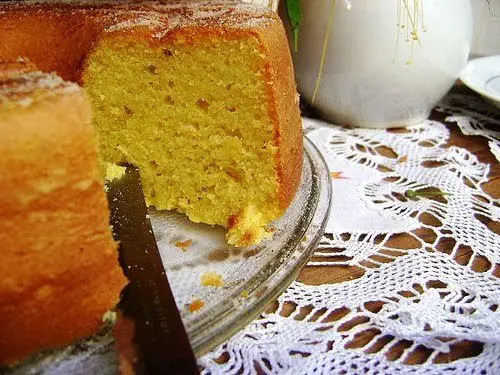
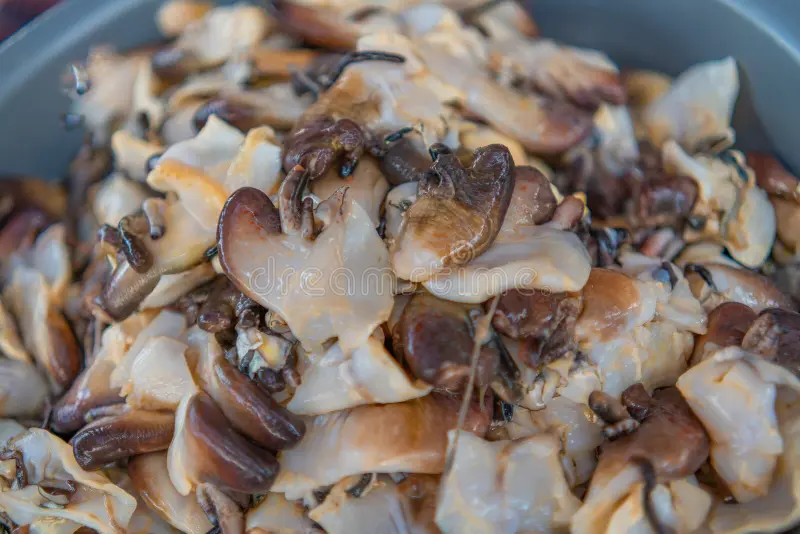
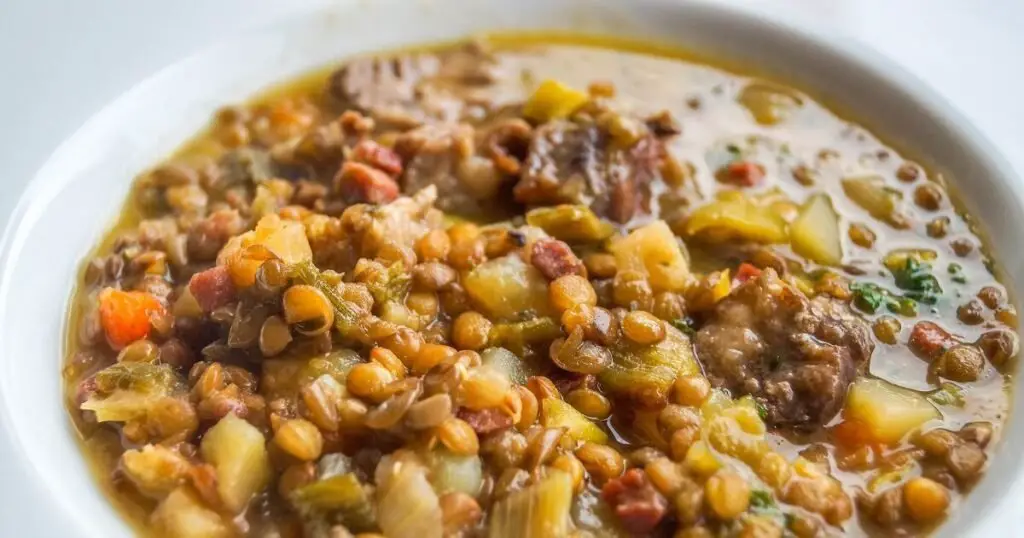
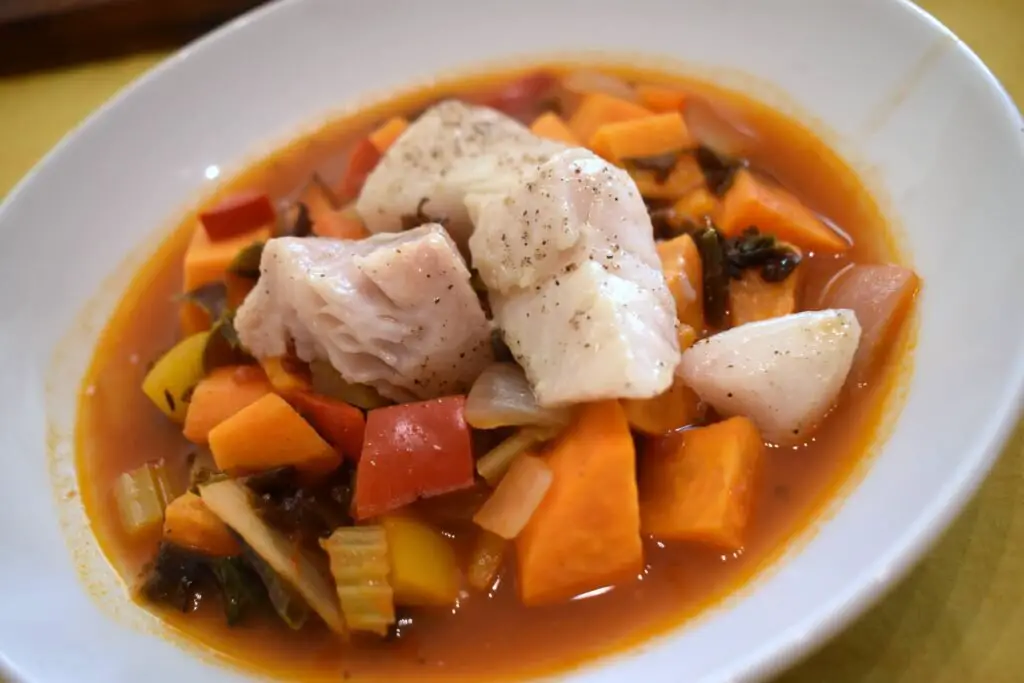
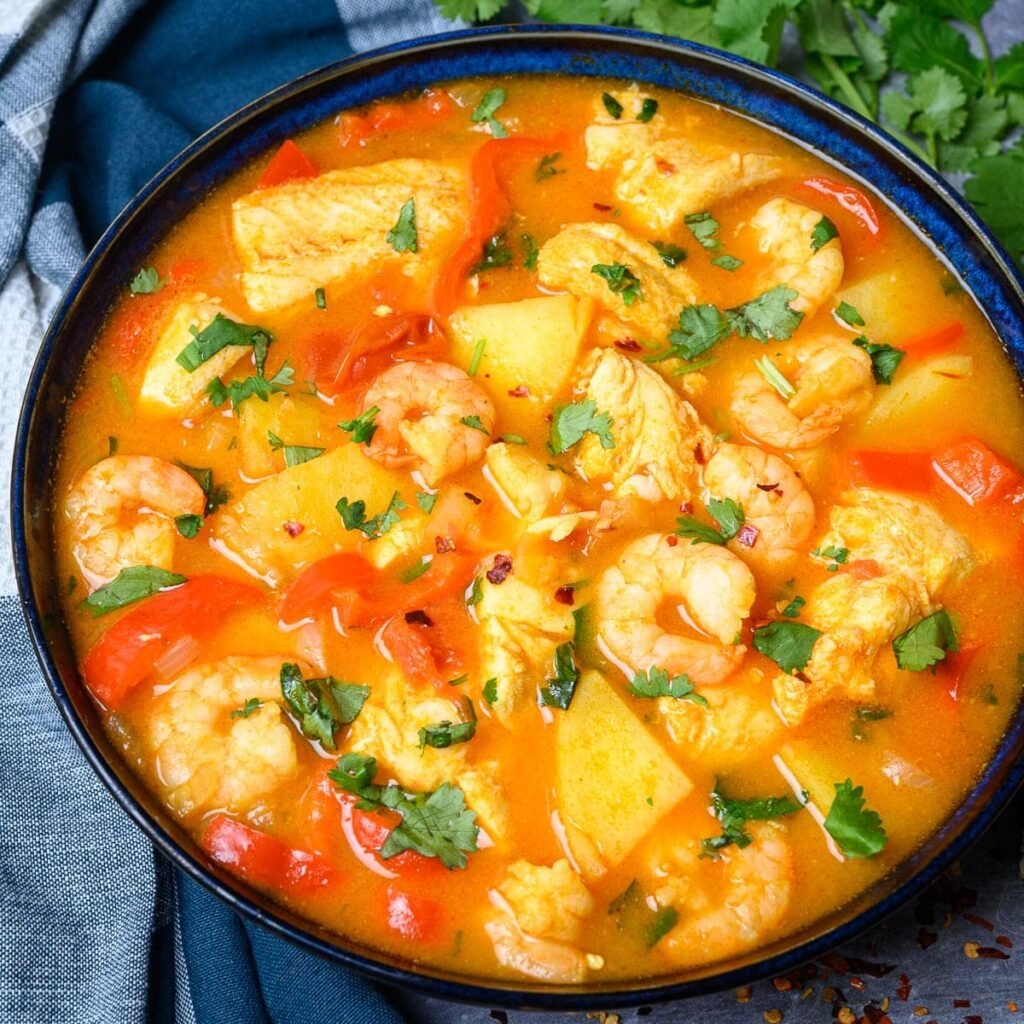
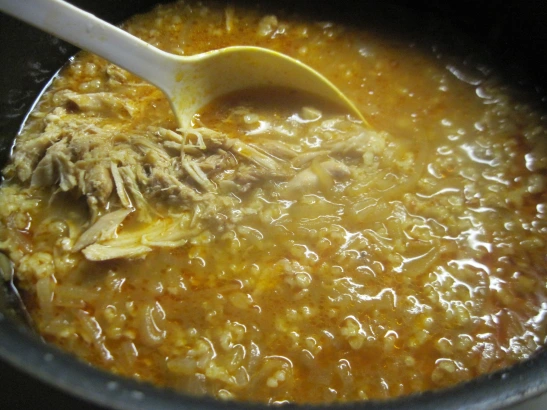
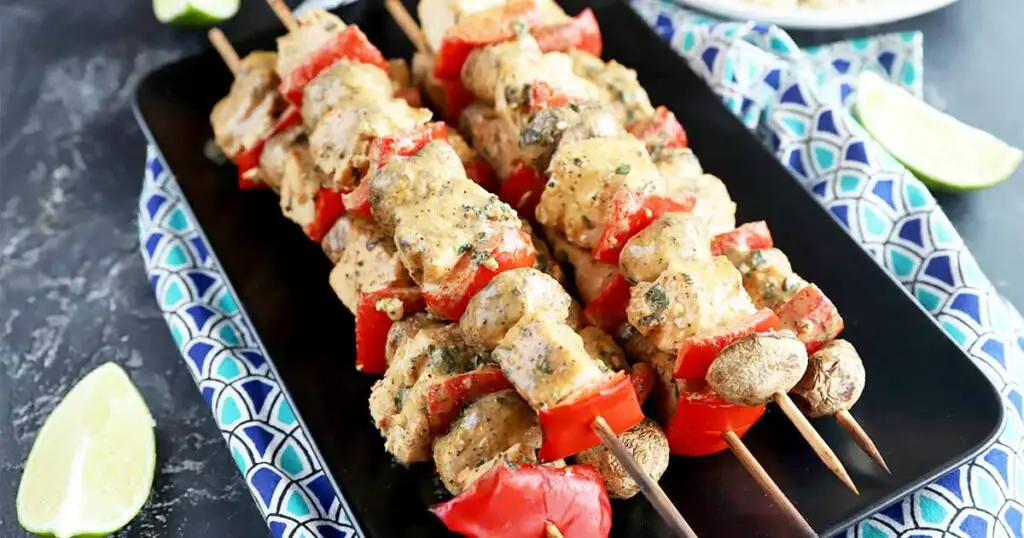
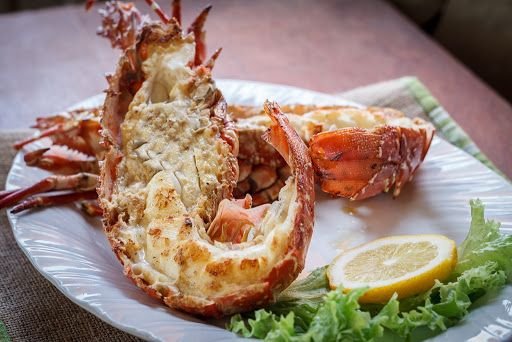
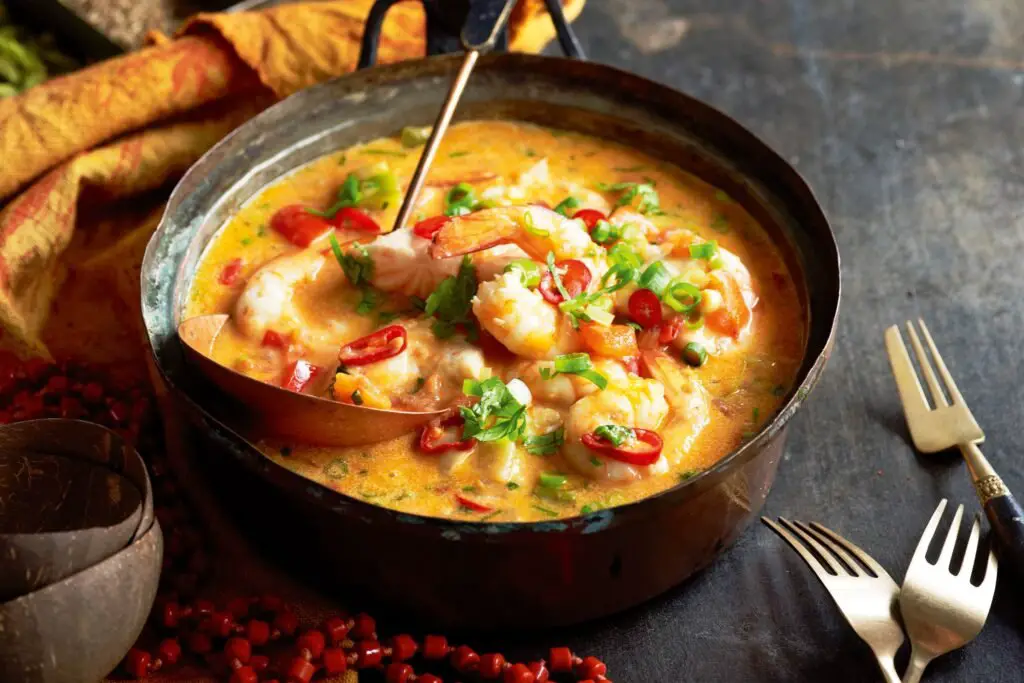

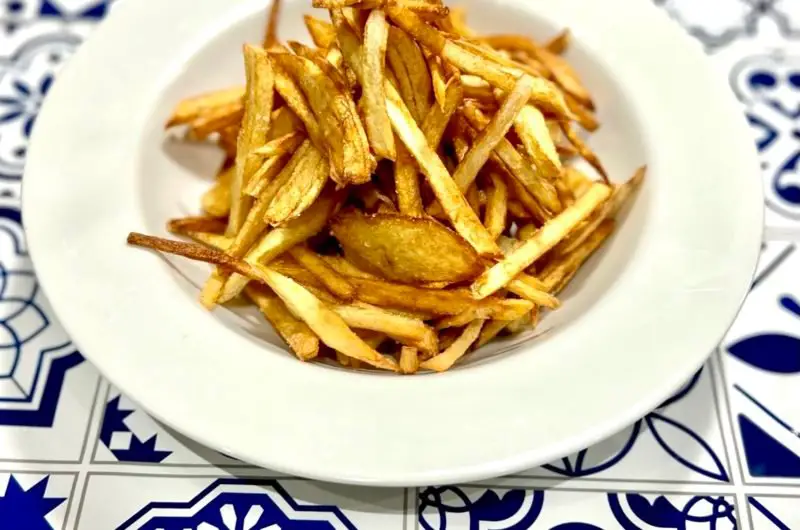
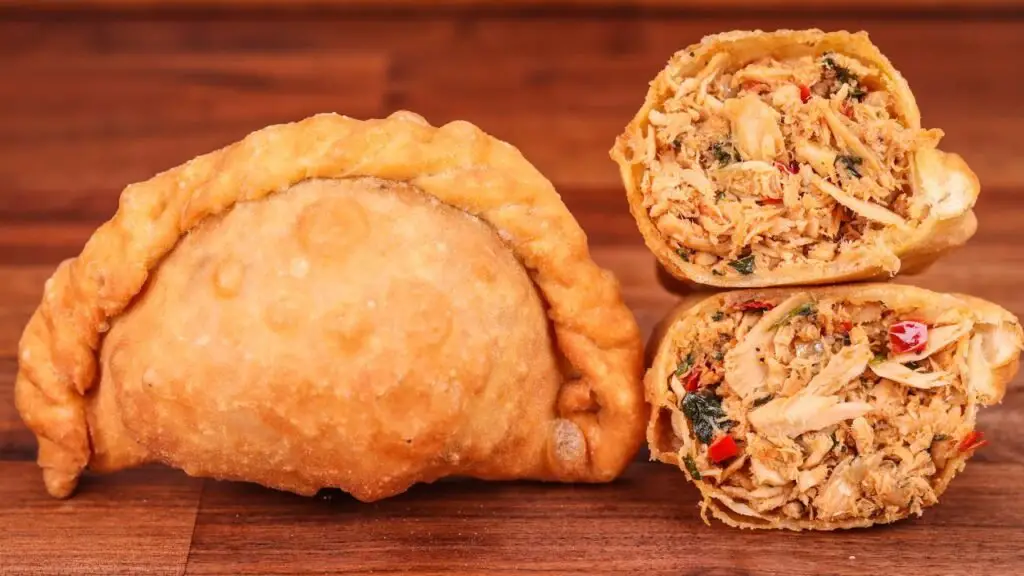

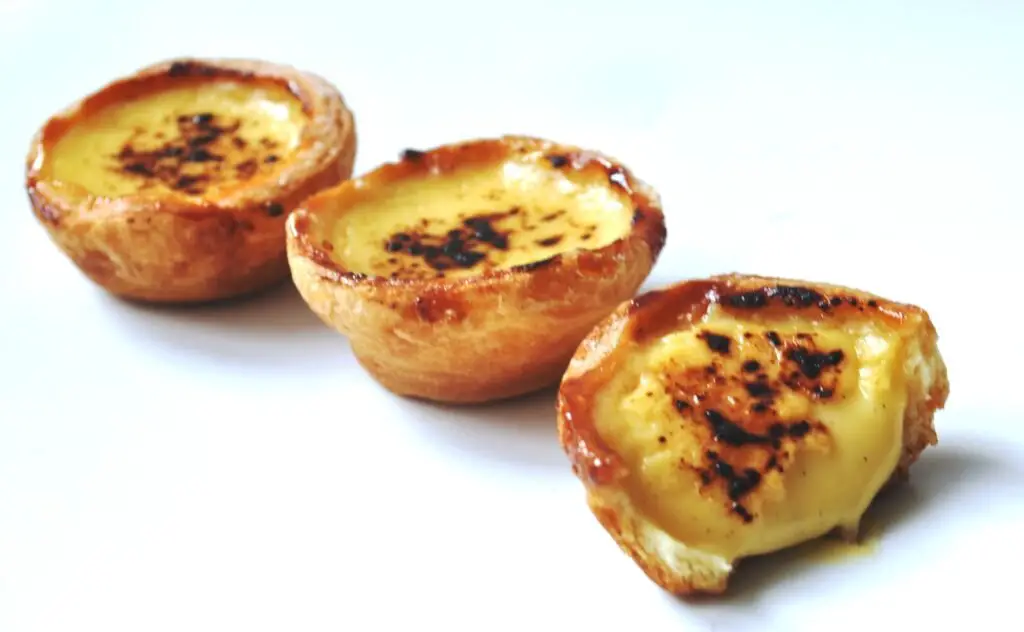



10 Interesting Facts about Cabo Verde

Island of Contrasts
Cabo Verde, a picturesque archipelago off the coast of West Africa, is a harmonious blend of diverse cultures, breathtaking landscapes, and intriguing laws.
Melting Pot of Cultures
With influences from Africa, Europe, and the Americas, Cabo Verde boasts a rich cultural tapestry reflected in its music, cuisine, and traditions.
Musical Heartbeat

Music is the soul of Cabo Verde, with genres like morna and funaná captivating listeners worldwide, evoking the spirit of the islands and its resilient people.
Women Empowerment
Cabo Verde stands out for its commitment to gender equality, with women holding key positions in government, business, and society.
Warm Hospitality

Known for its warm hospitality, Cabo Verde welcomes visitors with open arms, inviting them to experience the laid-back charm of island life.
Salty Traditions
Salt production has been a cornerstone of Cabo Verde’s economy for centuries, with salt flats dotting the landscape and offering a glimpse into the nation’s history.
Quirky Driving Laws

In Cabo Verde, it’s illegal to honk your horn unnecessarily, reflecting the country’s preference for peaceful coexistence on its tranquil streets.
Volcanic Wonders
The islands of Cabo Verde are volcanic in origin, with dramatic landscapes that range from rugged peaks to pristine beaches, offering adventurers a playground of natural beauty.
Creole Cuisine

Cabo Verdean cuisine is a delectable fusion of African, Portuguese, and Brazilian flavors, with dishes like cachupa and pastel de atum tantalizing taste buds with their unique blend of spices and ingredients.
Environmental Consciousness

Despite its small size, Cabo Verde is a pioneer in renewable energy, harnessing the power of wind and solar to reduce its reliance on fossil fuels and combat climate change.
From its vibrant culture to its stunning landscapes and progressive values, Cabo Verde continues to captivate travelers with its charm and allure, inviting them to explore its hidden treasures and embrace the rhythm of island life.
Cabo Verdean History and the Effect it has had on the Cuisine

Cabo Verde’s cuisine is a captivating story waiting to be savored. Let’s embark on a delicious journey through time to discover how history shaped the flavors of this island paradise. Buckle up, food adventurers – we’re diving into the fascinating past!
Setting Sail in the 15th Century
Imagine a chain of uninhabited islands discovered by Portuguese explorers in the mid-1400s. This is the dawn of Cabo Verde’s culinary story. The Portuguese brought new crops and culinary traditions, attempting to cultivate sugar cane – just like their success on Madeira.
While the dry climate wasn’t ideal for sugar, a far more lucrative opportunity emerged – the transatlantic slave trade.
A Hub of Trade and Transformation
Cabo Verde became a crucial trading center. European goods like rum, cloth, and even firearms were exchanged for enslaved people, gold, and ivory.
Interestingly, Cabo Verde was known for its valuable “pano cloths,” meticulously woven by enslaved people from locally grown cotton and dyed a deep indigo.
Droughts and Resourcefulness (18th Century)
Fast forward to the 1700s, and the islands faced their first of many challenges – devastating droughts and famines that struck roughly every five years. These natural disasters significantly impacted food availability, forcing people to adapt their cooking methods and ingredients.
Traditional dishes became more resourceful, utilizing every available scrap to create hearty meals during lean times.
A Fusion of Flavors: The Slave Trade’s Legacy (15th-19th Centuries)
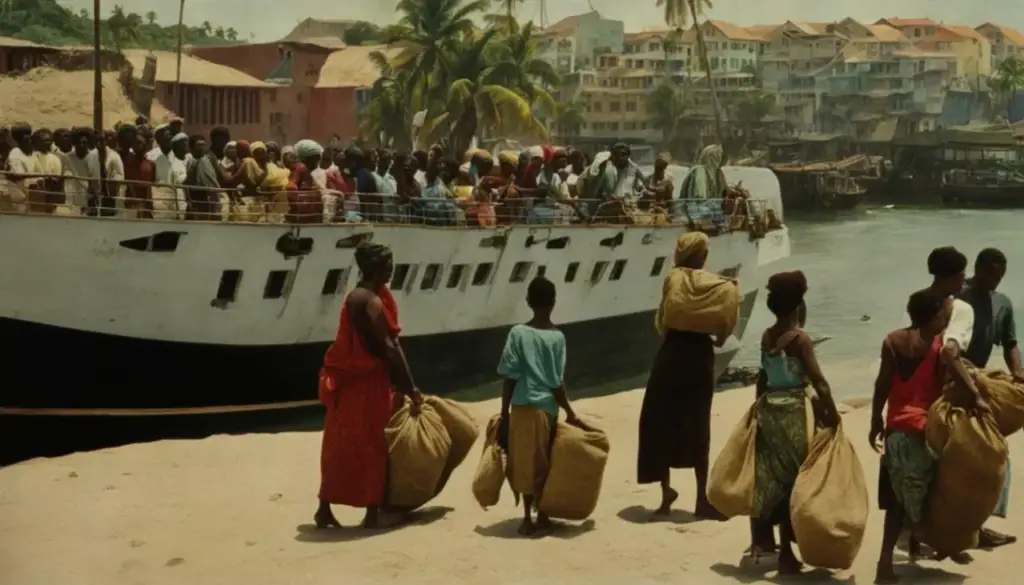
For centuries, Cabo Verde played a central role in the triangular trade. Enslaved people were transported from Africa to the New World, often passing through Cabo Verde. This trade left a profound mark on cuisine, introducing new African ingredients, cooking techniques, and vibrant flavors.
Think of “cachupa,” the beloved national dish – a hearty stew brimming with corn, beans, and various meats. This dish perfectly embodies the fusion of African, European, and indigenous influences that define Cabo Verdean cuisine.
Independence and Beyond (20th Century)

In 1975, Cabo Verde gained independence from Portugal, ushering in a renewed focus on local identity and cultural heritage. Food, of course, played a central role! Cabo Verdean cuisine continued to evolve, incorporating flavors from other countries due to increased migration and tourism.
While seafood, corn, beans, and tropical fruits remain staples, globalization has introduced new ingredients and cooking styles. It’s a testament to the dynamic nature of Cabo Verdean culture, much like the vibrant music and dance that complement this rich culinary tapestry.
Ready to Explore?
This is just a taste of the captivating history that flavors every bite in Cabo Verde. So, delve deeper into the references provided to truly appreciate the depth of Cabo Verde’s culinary heritage.
References
How the Cabo Verdean Climate and Geography has Influenced the Cuisine

Let’s embark on a delicious adventure to discover how location, climate, and geography have woven a tapestry of flavors across each island.
Location: A Crossroads of Cultures
Cabo Verde’s strategic position near major trade routes has made it a historical melting pot. Portuguese, Brazilian, and African influences all come together on your plate.
Imagine the aroma of Portuguese stews mingling with the vibrant spices of Africa – a true testament to the island’s rich cultural exchange!
Climate: Shaping a Cuisine of Resilience

The islands fall within the Sahel region, known for its semi-arid climate. This dry environment has shaped Cabo Verdean cuisine, emphasizing ingredients that thrive in these conditions.
Think hardy crops like corn, beans, and cassava, all forming the base for delicious and filling dishes.
Corn: The Golden Thread
Corn reigns supreme in Cabo Verdean cuisine. It’s the star of “Cuscuz de Milho” (a cornmeal delight), the base of the national dish “catchupa,” and a tasty treat enjoyed grilled on the cob as “mitxe ilhod.”
Catchupa: A Celebration in Every Bite
No journey through Cabo Verdean cuisine is complete without encountering catchupa, the beloved national stew. Each island boasts its own unique twist on this hearty dish.
The foundation is always slow-cooked corn and beans, but the magic happens with the addition of ingredients like salty meats, garlic, onions, and a sprinkle of spices. “Catchupa rica” ups the ante with vegetables and potatoes, while a simpler version remains a local favorite.
Island Flavors: A Delicious Adventure

Here’s a taste of the culinary treasures waiting for you on each island:
- Santiago: The heart of Cabo Verde, known for its stews like catchupa.
- Boa Vista: Embrace the desert vibes with a focus on fresh seafood.
- São Vicente: Mindelo’s vibrant city life is reflected in a diverse food scene influenced by international trade.
- Fogo: Volcanic soil nourishes unique wines and coffee.
- Sal: Sun, sand, and a bounty of fresh seafood await.
- Maio: Simplicity reigns supreme with fresh, local ingredients.
- Brava: Savor sweet potato dishes and traditional specialties.
- Santo Antão: Indulge in a bounty of fruits and vegetables alongside hearty stews.
- Santa Luzia: Uninhabited but a haven for fish lovers.
- São Nicolau: Explore a delightful mix of seafood and comforting dishes.
A Culinary Adventure Awaits
Cabo Verdean cuisine is a vibrant symphony of flavors, a story waiting to be savored on each island.
So, pack your appetite and embark on a culinary adventure – explore the national treasure of catchupa, discover regional specialties, and experience the rich heritage woven into every bite!
References
- Britannica: Cultural Life in Cabo Verde
- Chef’s Pencil: Top 20 Foods of Cape Verde
- Travel Food Atlas: Cape Verde Food
- Paulina on the Road: Traditional Cape Verdean Food
Understanding the Essence of Cabo Verdean Cuisine
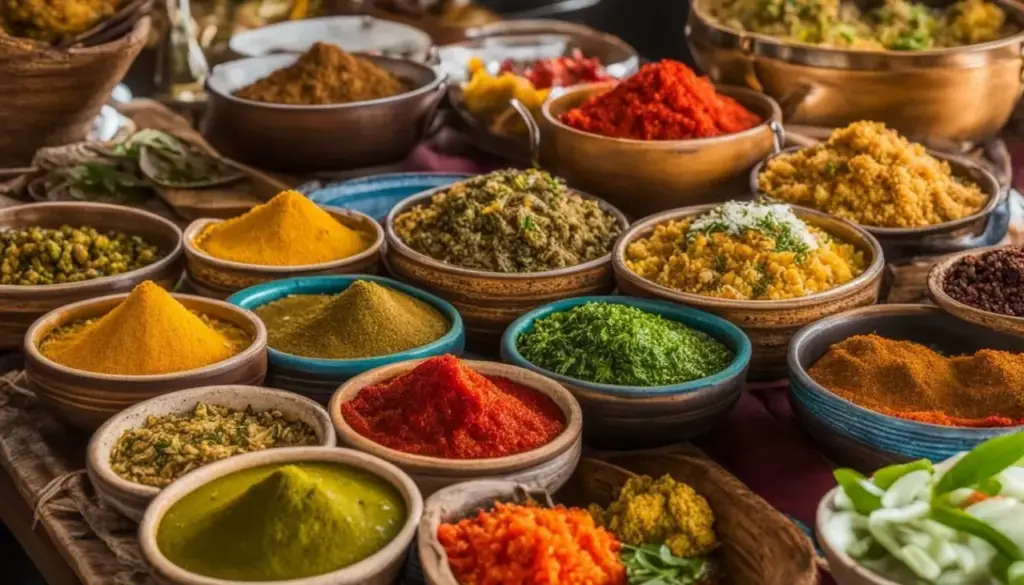
The essence of Cabo Verde cuisine is a vibrant reflection of its history, geography, and cultural heritage, blending flavors from Africa, Portugal, and Brazil into a tapestry of taste that is as diverse as the islands themselves.
A Fusion of Cultures
Cabo Verde’s cuisine is a testament to its rich history of cultural exchange. From the indigenous flavors of Africa to the spices brought by Portuguese explorers and the influence of Brazilian culinary traditions, each dish tells a story of migration, trade, and adaptation.
This fusion of cultures creates a unique culinary landscape that sets Cabo Verde apart from its neighbors.
Fresh and Flavorful Ingredients
At the heart of Cabo Verdean cuisine lies a bounty of fresh and flavorful ingredients sourced from the land and sea. From the succulent seafood caught off the coast to the tropical fruits and vegetables grown in the volcanic soil, every dish bursts with the vibrant colors and bold flavors of the islands.
Staples like maize, beans, and sweet potatoes form the foundation of many meals, complemented by aromatic herbs and spices that add depth and complexity to each bite.
Seafood Delights
Given its island location, it’s no surprise that seafood plays a starring role in Cabo Verdean cuisine. From grilled fish to savory stews brimming with lobster, shrimp, and octopus, the bounty of the sea is celebrated in dishes that are as fresh as they are delicious.
One iconic dish is “cachupa de peixe,” a hearty fish stew simmered with vegetables and served with rice or cornmeal, showcasing the abundance of marine life that thrives in the waters surrounding the islands.
Comforting Stews and Hearty Soups
Cabo Verde’s cuisine is also renowned for its comforting stews and hearty soups, which provide nourishment and warmth to both body and soul.
“Cachupa,” the national dish of Cabo Verde, is a hearty stew made with corn, beans, and a variety of meats or fish, simmered slowly to develop rich flavors and tender textures.
Another favorite is “canja,” a chicken soup infused with fragrant herbs and spices, believed to have healing properties and often served to celebrate special occasions.
Sweet Endings
No meal in Cabo Verde is complete without a sweet ending, and the islands offer an array of delectable desserts to satisfy any sweet tooth.
From the creamy indulgence of “flan” to the tropical delights of “pudim de coco” (coconut pudding) and “pastéis de nata” (custard tarts), Cabo Verde’s desserts are a testament to the islands’ love affair with sugar and spice.
Exploring Cabo Verde’s Ingredients: The Flavors of Cabo Verdean Cuisine
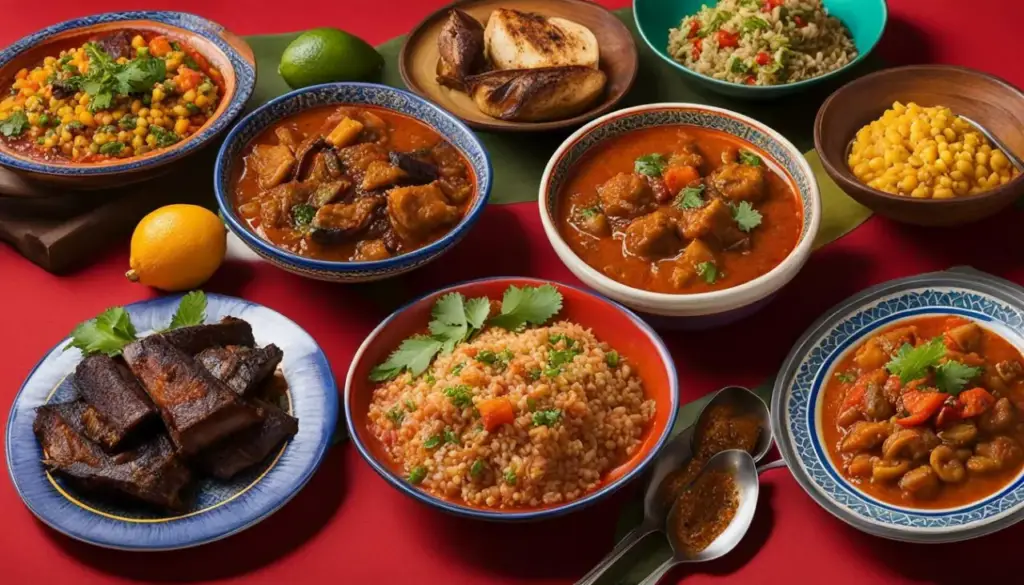
Cabo Verdean cuisine is a celebration of fresh, vibrant flavors that reflect the diverse landscapes and cultural influences of the islands.
From succulent seafood caught off the coast to hearty stews simmered with local spices, the main ingredients used in Cabo Verdean cooking form the foundation of its rich culinary heritage. Let’s delve into the key components that make Cabo Verde cuisine so unique and flavorful.
Maize (Corn)
Maize, or corn, is a staple ingredient in Cabo Verdean cuisine, serving as the base for many dishes. Whether ground into flour for making “cachupa” (a traditional stew) or served as a side dish in the form of “cuscus” (cornmeal), maize is a versatile ingredient that provides sustenance and texture to meals.
Beans
Beans are another essential ingredient in Cabo Verdean cooking, adding protein, fiber, and depth of flavor to dishes.
Commonly used varieties include black beans, kidney beans, and butter beans, which are simmered with spices and other ingredients to create hearty stews and soups.
Sweet Potatoes
Sweet potatoes are a beloved ingredient in Cabo Verdean cuisine, prized for their natural sweetness and versatility. Whether boiled, roasted, or mashed, sweet potatoes feature prominently in many dishes, adding a touch of sweetness and earthiness to meals.
Fish and Seafood
Given its island location, it’s no surprise that fish and seafood are abundant in Cabo Verdean cuisine. From tuna and mackerel to lobster and shrimp, the bounty of the sea is celebrated in dishes like “cachupa de peixe” (fish stew) and “caldeirada” (seafood stew), where fresh catch is simmered with vegetables and aromatic spices.
Tropical Fruits and Vegetables
Cabo Verde’s tropical climate supports the growth of a variety of fruits and vegetables, which are used to add brightness and flavor to dishes.
Mangoes, papayas, bananas, and pineapples are commonly enjoyed as snacks or incorporated into salads and desserts, while vegetables like tomatoes, onions, and peppers are essential for adding depth and color to savory dishes.
Herbs and Spices
Herbs and spices play a crucial role in Cabo Verdean cooking, infusing dishes with complex flavors and aromas. Commonly used herbs include parsley, cilantro, and mint, while spices like cumin, paprika, and cinnamon add warmth and depth to sauces, stews, and marinades.
Cabo Verdean National Food
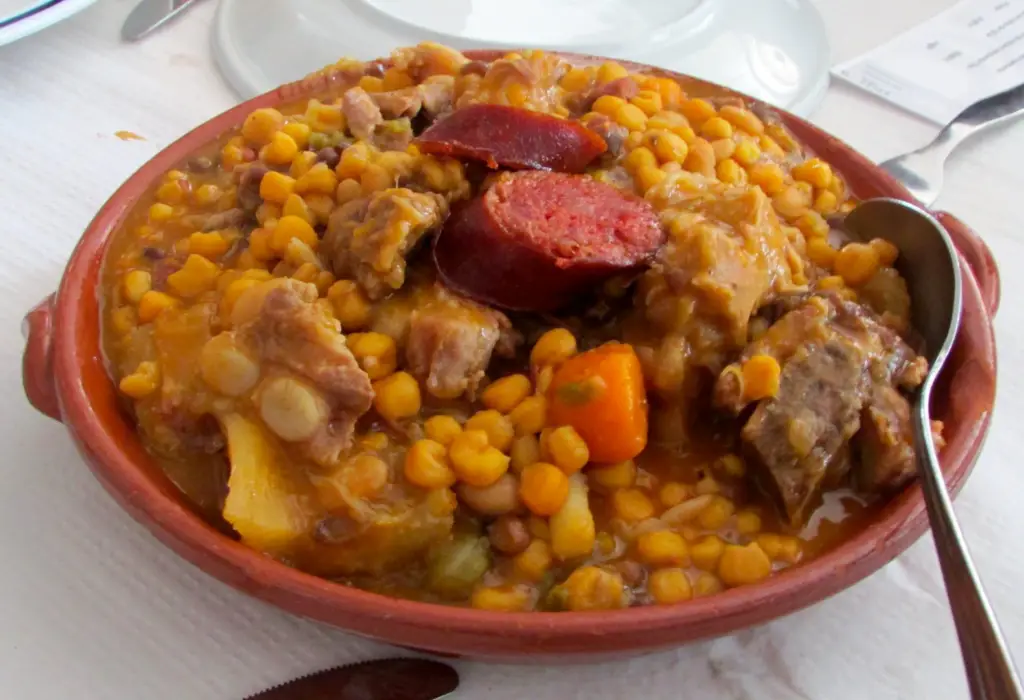
Cabo Verde’s culinary identity is epitomized by its national dish, cachupa. This hearty and comforting stew embodies the essence of the islands, showcasing a blend of flavors and ingredients that reflect the rich cultural heritage and resourcefulness of its people.
Let’s delve into the history, ingredients, and significance of cachupa in Cabo Verdean cuisine.
A Culinary Tradition
Cachupa holds a special place in the hearts and palates of Cabo Verdeans, serving as a symbol of family, community, and resilience.
Originally brought to the islands by African slaves, cachupa has evolved over centuries, adapting to the available ingredients and cultural influences to become the beloved dish it is today.
Ingredients
While there are countless variations of cachupa, the basic ingredients remain consistent across recipes. The foundation of cachupa is maize (corn), which is simmered with beans (such as kidney beans or butter beans), along with a variety of meats or fish.
Common additions include sweet potatoes, pumpkin, onions, tomatoes, and aromatic herbs and spices like garlic, bay leaves, and paprika.
Preparation
The preparation of cachupa is a labor of love, often requiring hours of slow cooking to develop the rich flavors and tender textures that define the dish.
Traditionally, cachupa is cooked in a large pot over an open fire, allowing the ingredients to simmer and meld together to create a hearty and satisfying meal.
Variations
While cachupa is considered the national dish of Cabo Verde, there are regional variations that reflect the unique flavors and ingredients of each island.
In Santiago, for example, cachupa is often made with red beans and a spicy sausage known as linguica, while in São Vicente, it may feature more seafood and coconut milk.
Cultural Significance
Beyond its culinary appeal, cachupa holds cultural significance for Cabo Verdeans, often served during festive occasions and family gatherings. It is a dish that brings people together, fostering a sense of unity and connection to the islands’ shared heritage.
Traditional Examples of Cabo Verdean Food

Let’s explore five classic dishes that exemplify the essence of Cabo Verdean culinary tradition.
1. Cachupa
No exploration of Cabo Verdean cuisine is complete without mentioning cachupa, the national dish of the islands. This hearty stew is made with maize (corn) and beans, simmered with a variety of meats or fish, vegetables, and aromatic herbs and spices.
Slow-cooked to perfection, cachupa is a comforting and satisfying meal that reflects the resourcefulness and resilience of Cabo Verdean cooking.
2. Catchupa Rica
Similar to cachupa, catchupa rica is a deluxe version of the traditional stew, often served during special occasions and celebrations. It features a richer variety of meats, including chorizo, pork, and beef, along with a generous helping of vegetables and spices.
The result is a flavorful and indulgent dish that highlights the vibrant flavors of Cabo Verdean cuisine.
3. Pastel de Atum
Pastel de atum, or tuna pastries, are a beloved snack in Cabo Verde, enjoyed by locals and visitors alike. These savory pastries are filled with a delicious mixture of canned tuna, onions, tomatoes, and spices, then wrapped in pastry dough and fried until golden and crispy.
Served hot and fresh, pastel de atum is the perfect on-the-go treat for exploring the streets of Cabo Verde.
4. Lagostada
Lagostada is a decadent seafood dish that showcases the abundance of the ocean surrounding the islands. It features lobster tails sautéed in a flavorful sauce made with garlic, onions, tomatoes, and aromatic herbs and spices.
Served with rice or crusty bread, lagostada is a luxurious indulgence that captures the essence of Cabo Verdean coastal cuisine.
5. Buzio Recheado
Buzio recheado, or stuffed whelks, is a traditional Cabo Verdean delicacy that highlights the islands’ love for seafood. Whelks are cleaned and stuffed with a savory mixture of onions, garlic, breadcrumbs, and spices, then baked until tender and fragrant.
Served as a starter or main course, buzio recheado is a flavorful and unique dish that showcases the culinary creativity of Cabo Verdean cooks.
Exploring Cabo Verdean Street Food

Cabo Verde’s Street food scene is a vibrant tapestry of flavors, aromas, and culinary traditions that reflect the diverse cultural heritage and bustling energy of the islands. From savory snacks to sweet treats, the streets of Cabo Verde offer a culinary adventure like no other.
Let’s dive into the heart of Cabo Verdean street food and explore five common recipes sold on the streets, along with the cities where you can experience the most vibrant street food scene.
1. Pastel de Atum (Tuna Pastries)
One of the most popular street food snacks in Cabo Verde, pastel de atum, or tuna pastries, are delicious turnovers filled with a savory mixture of canned tuna, onions, tomatoes, and spices.
These crispy pastries are perfect for a quick bite on the go and can be found at street stalls and bakeries throughout the islands.
2. Bolo de Caco (Cornbread)
Bolo de caco, a traditional cornbread cooked on a flat stone (caco), is a staple of Cabo Verdean street food. Served warm and topped with garlic butter or spicy piri piri sauce, this simple yet satisfying snack is a favorite among locals and visitors alike.
3. Queijo Fresco (Fresh Cheese)
Queijo fresco, or fresh cheese, is a popular street food item in Cabo Verde, especially in the city of Praia. Made from locally sourced milk, this creamy cheese is often served with crusty bread or sweet fruits like papaya or mango, providing a refreshing and satisfying snack on a hot day.
4. Pastel de Milho (Corn Pastries)
Pastel de milho, or corn pastries, are another beloved street food snack in Cabo Verde.
These golden-brown pastries are filled with a sweet or savory mixture of cornmeal, sugar, and spices, offering a deliciously indulgent treat that is perfect for satisfying a sweet craving.
5. Espetada de Peixe (Fish Skewers)
Espetada de peixe, or fish skewers, are a popular street food dish in Cabo Verde, particularly in coastal cities like Mindelo and Sal Rei.
Fresh fish, often marinated in a zesty blend of garlic, lemon, and herbs, is skewered and grilled to perfection, resulting in a flavorful and satisfying meal that captures the essence of Cabo Verdean coastal cuisine.
Cities with Vibrant Street Food Scenes
While street food can be found throughout Cabo Verde, certain cities are renowned for their vibrant street food scenes. Praia, the capital city, boasts a diverse array of street vendors offering everything from traditional snacks to innovative fusion dishes.
Mindelo, located on the island of São Vicente, is another hotspot for street food, with bustling markets and waterfront stalls serving up fresh seafood and local specialties.
The Most Popular Cabo Verdean Recipes

Cabo Verdean cuisine is a delightful fusion of flavors, blending influences from Africa, Portugal, and Brazil to create a unique culinary experience. From hearty stews to fresh seafood dishes and sweet treats, here are 10 of the most popular Cabo Verde recipes that are sure to tantalize your taste buds:
1. Cachupa
Cachupa is the national dish of Cabo Verde, a hearty stew made with maize (corn), beans, and a variety of meats or fish. Slow-cooked with vegetables and aromatic spices, cachupa is a comforting and satisfying meal that reflects the resilience and resourcefulness of Cabo Verdean cooking.
2. Catchupa Rica
Similar to cachupa, catchupa rica is a deluxe version of the traditional stew, featuring a richer variety of meats such as chorizo, pork, and beef, along with a generous helping of vegetables and spices. It’s often served during special occasions and celebrations, showcasing the vibrant flavors of Cabo Verdean cuisine.
3. Lagostada
Lagostada is a decadent seafood dish made with lobster tails sautéed in a flavorful sauce of garlic, onions, tomatoes, and aromatic herbs and spices. Served with rice or crusty bread, lagostada is a luxurious indulgence that highlights the bounty of the ocean surrounding the islands.
4. Buzio Recheado
Buzio recheado, or stuffed whelks, is a traditional Cabo Verdean delicacy made by stuffing cleaned whelks with a savory mixture of onions, garlic, breadcrumbs, and spices, then baking them until tender and fragrant. It’s a flavorful and unique dish that showcases the culinary creativity of Cabo Verdean cooks.
5. Pastel de Atum
Pastel de atum, or tuna pastries, are savory turnovers filled with a delicious mixture of canned tuna, onions, tomatoes, and spices. These crispy pastries are perfect for a quick snack on the go and are commonly found at street stalls and bakeries throughout the islands.
6. Canja
Canja is a comforting chicken soup made with tender pieces of chicken, rice, and fragrant herbs and spices. Often served during festive occasions or as a remedy for colds and illnesses, canja is a soothing and nourishing dish that is loved by Cabo Verdeans of all ages.
7. Moqueca de Peixe
Moqueca de peixe is a flavorful fish stew made with fresh fish, tomatoes, onions, peppers, and coconut milk. Seasoned with garlic, lime juice, and cilantro, this aromatic stew is simmered to perfection, resulting in a dish that is rich, savory, and bursting with tropical flavors.
8. Pastel de Bacalhau
Pastel de bacalhau, or codfish pastries, are crispy fritters made with salted codfish, potatoes, onions, and parsley. These golden-brown pastries are a popular appetizer or snack in Cabo Verde, often served with spicy piri piri sauce for dipping.
9. Papas Fritas
Papas fritas are crispy fried potatoes seasoned with salt and served as a side dish or snack. Whether enjoyed on their own or alongside other Cabo Verdean dishes, papas fritas are a simple yet delicious addition to any meal.
10. Queijada de Coco
Queijada de coco is a sweet coconut tart made with grated coconut, sugar, eggs, and spices. Baked until golden and fragrant, these individual tarts are a popular dessert in Cabo Verde, enjoyed by locals and visitors alike for their rich, creamy texture and tropical flavor.
How Healthy is Cabo Verdean Food?
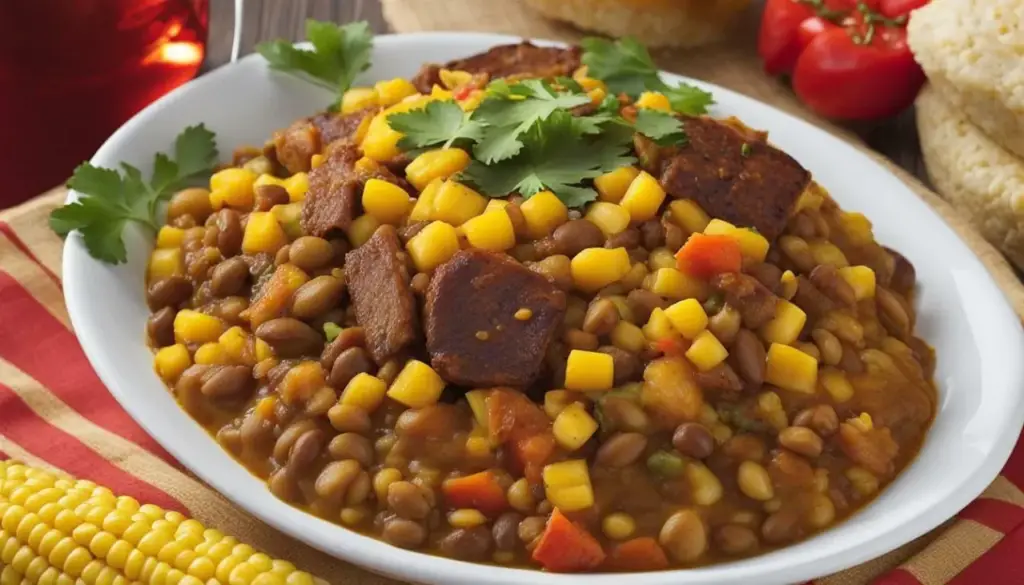
Cabo Verde, a nation of breathtaking beauty, is also facing a growing challenge: non-communicable diseases (NCDs) like diabetes, heart disease, and obesity.
While life expectancy has improved significantly (reaching 74 years in 2019), these lifestyle-related illnesses threaten to reverse that progress.
Diet and the NCD Challenge
The Cabo Verdean diet plays a role in NCD prevalence. Here’s what the data reveals:
- Obesity: While Cabo Verde boasts lower obesity rates than the region’s average (18.9% of adult women and 8.5% of adult men), tackling obesity remains a crucial health priority.
- Diabetes: A significant concern is diabetes, affecting 9.4% of adult women and 10.9% of adult men. Managing diabetes requires close blood sugar monitoring and healthy eating habits.
- Heart Health: Ischemic heart disease, a major cause of death, is linked to factors like high blood pressure and cholesterol. Encouraging heart-healthy diets and regular exercise is key to prevention.
Balancing the Scale
While specific data on cholesterol levels is limited, maintaining healthy cholesterol through a balanced diet low in saturated and trans fats is crucial.
Positive Signs and Areas for Improvement
- Life Expectancy: The upward trend in life expectancy (from 71 years in 2000 to 74 years in 2019) indicates positive changes in overall health and living conditions.
- Leading Causes of Death: The leading causes of death in Cabo Verde offer insight into health priorities. Ischemic heart disease, stroke, and diabetes highlight the need to address NCD risk factors.
Looking Ahead: A Healthier Future
Cabo Verde has the opportunity to create a healthier future for its citizens. Promoting balanced diets, regular physical activity, and preventive measures can significantly improve overall well-being.
References
- Global Nutrition Report: Cabo Verde Nutrition Profile
- World Health Organization: Cabo Verde Health Data Overview
- WHO Country Profile: Diabetes in Cabo Verde
- WHO: Country Disease Outlook for Cabo Verde
Cabo Verdean Cuisine Recipes to Try at Home

Transport your taste buds to the sun-drenched shores of Cabo Verde with our curated collection of traditional recipes.
Delve into the vibrant flavors and rich culinary heritage of the islands as you explore a diverse array of dishes, from hearty stews to fresh seafood delights and indulgent desserts.
Whether you’re craving the comfort of cachupa or the sweetness of queijada de coco, these authentic Cabo Verde recipes are sure to bring a taste of island paradise to your kitchen.
Cape Verde Food – Cachupa

Exploring Cabo Verdean Cuisine: Cachupa Recipe
Hey there, fellow food adventurers! Today, I’m thrilled to share with you a taste of Cabo Verde with our authentic recipe for Cachupa. As a traveling food blogger who’s also passionate about bringing global flavors to my small restaurant back home.
I can’t wait for you to experience the rich and comforting flavors of this traditional Cabo Verdean dish. Let’s dive into the history and origins of Cachupa before we get cooking!
History and Background
Cachupa is more than just a meal in Cabo Verde; it’s a symbol of the islands’ resilience and resourcefulness. Originating from the days of slavery, when African slaves would cook a hearty stew with whatever ingredients they had on hand, Cachupa has evolved over the centuries to become the national dish of Cabo Verde.
Today, it’s enjoyed by locals and visitors alike, with each island putting its own unique twist on the recipe.
Cape Verde Food – Cachupa Ingredients
- 1 cup of maize (corn)
- 1 cup of dried beans (such as kidney beans or butter beans)
- 4 cups of water
- 1 onion, chopped
- 2 cloves of garlic, minced
- 2 tomatoes, diced
- 1 bell pepper, chopped
- 1 sweet potato, diced
- 1 chorizo sausage, sliced
- 1/2 lb of pork belly, diced
- Salt and pepper to taste
- A handful of fresh cilantro, chopped (for garnish)
- Hot sauce (optional, for serving)
Cape Verde Food – Cachupa Recipe
Ingredients:
- 4-6 servings
Cooking Time:
- Approximately 2 hours
Nutritional Information:
- Calories: 350 per serving
- Protein: 15g
- Fat: 12g
- Carbohydrates: 45g
- Fiber: 10g
Prepare the Maize and Beans
- In a large pot, combine the maize and dried beans with water. Bring to a boil, then reduce heat and simmer for about 1 hour, or until the beans are tender.
Cook the Base
- In another pot, heat some olive oil over medium heat. Add the chopped onion, minced garlic, diced tomatoes, and bell pepper. Cook until the vegetables are softened and fragrant.
Add the Meats and Vegetables
- Once the vegetables are cooked, add the sliced chorizo sausage and diced pork belly to the pot. Cook until the meats are browned and caramelized.
- Next, add the cooked maize and beans to the pot, along with the diced sweet potato. Stir everything together and season with salt and pepper to taste.
Simmer and Serve
- Cover the pot and let the Cachupa simmer for another 30-45 minutes, or until the flavors have melded together and the sweet potato is tender.
- Once the Cachupa is ready, garnish with fresh chopped cilantro and serve hot, with a side of hot sauce for those who like it spicy.
Now that you have the recipe for Cachupa, it’s time to bring a taste of Cabo Verde into your own kitchen! Whether you’re cooking for friends and family or simply craving a cozy and comforting meal, this traditional Cabo Verdean dish is sure to hit the spot. Enjoy
Cape Verde Food – Cachupa De Peixe (Fish Stew)

Exploring Cabo Verdean Cuisine: Cachupa De Peixe (Fish Stew) Recipe
Hey foodie adventurers! Today, I’m excited to share a taste of Cabo Verde with our recipe for Cachupa De Peixe, a flavorful fish stew that captures the essence of this beautiful island nation. As a traveler and restaurant owner, I’m always on the lookout for dishes that bring people together and tell a story of culture and tradition.
Let’s dive into the history and origins of Cachupa De Peixe before we embark on this culinary journey!
History and Background
Cachupa De Peixe, or Fish Stew, is a beloved dish in Cabo Verdean cuisine, deeply rooted in the country’s maritime heritage and vibrant coastal culture. Originating from the islands of Cabo Verde, this hearty stew reflects the bounty of the ocean and the rich flavors of the region.
Whether enjoyed by locals on a bustling street corner or savored by visitors in a seaside restaurant, Cachupa De Peixe is a dish that brings people together to share in the warmth and hospitality of Cabo Verde.
Cape Verde Food – Cachupa De Peixe Ingredients
- 1 lb of fresh fish fillets (such as tuna, mackerel, or grouper)
- 2 tablespoons of olive oil
- 1 onion, chopped
- 2 cloves of garlic, minced
- 2 tomatoes, diced
- 1 bell pepper, chopped
- 1 cup of fish or vegetable broth
- 1 cup of coconut milk
- 1 cup of cooked maize (corn)
- 1 cup of cooked beans (such as kidney beans or butter beans)
- Salt and pepper to taste
- A handful of fresh cilantro, chopped (for garnish)
- Lime wedges (for serving)
Cape Verde Food – Cachupa De Peixe Recipe
Ingredients:
- Serves 4-6 people
Cooking Time:
- Approximately 45 minutes
Nutritional Information (per serving):
- Calories: 300
- Protein: 25g
- Fat: 15g
- Carbohydrates: 20g
- Fiber: 5g
Prepare the Fish
- Season the fish fillets with salt and pepper, then set aside.
Cook the Base
- In a large pot, heat the olive oil over medium heat. Add the chopped onion, minced garlic, diced tomatoes, and chopped bell pepper. Cook until the vegetables are softened and fragrant.
Add the Broth and Coconut Milk
- Once the vegetables are cooked, add the fish or vegetable broth and coconut milk to the pot. Bring to a simmer.
Add the Fish, Maize, and Beans
- Gently add the seasoned fish fillets to the pot, making sure they are submerged in the broth. Add the cooked maize and beans as well. Simmer for about 15-20 minutes, or until the fish is cooked through and the flavors have melded together.
Serve and Garnish
- Once the Cachupa De Peixe is ready, ladle it into bowls and garnish with fresh chopped cilantro. Serve hot, with lime wedges on the side for squeezing over the stew.
Now that you have the recipe for Cachupa De Peixe, it’s time to bring the flavors of Cabo Verde into your own kitchen! Whether you’re hosting a dinner party or simply craving a taste of the islands, this fish stew is sure to delight your taste buds and transport you to the sunny shores of Cabo Verde. Enjoy!
Cape Verde Food – Caldeirada

Exploring Cabo Verdean Cuisine: Caldeirada Recipe
Hey fellow foodies and adventurers! Today, I’m thrilled to share a taste of Cabo Verde with our recipe for Caldeirada, a flavorful fish stew that’s a true culinary gem of the islands. As someone who loves to travel and share delicious dishes with my restaurant patrons back home, I can’t wait to introduce you to this traditional Cabo Verdean delight.
But before we get cooking, let’s dive into the history and background of Caldeirada and the region it hails from.
History and Background
Caldeirada is a beloved dish in Cabo Verdean cuisine, deeply rooted in the country’s maritime heritage and coastal culture. Originating from the islands of Cabo Verde, this hearty fish stew reflects the bounty of the ocean and the vibrant flavors of the region.
Whether enjoyed by locals in a seaside village or savored by visitors at a beachfront restaurant, Caldeirada is a dish that brings people together to celebrate the richness of Cabo Verdean cuisine.
Cape Verde Food – Caldeirada Ingredients
- 1 lb of assorted fresh fish fillets (such as tuna, swordfish, and grouper)
- 1 onion, thinly sliced
- 2 cloves of garlic, minced
- 2 tomatoes, sliced
- 1 bell pepper, sliced
- 1 potato, thinly sliced
- 1 carrot, thinly sliced
- 1/2 cup of white wine
- 1/4 cup of olive oil
- Salt and pepper to taste
- A handful of fresh cilantro, chopped (for garnish)
- Lemon wedges (for serving)
Cape Verde Food – Caldeirada Recipe
Ingredients:
- Serves 4-6 people
Cooking Time:
- Approximately 45 minutes
Nutritional Information (per serving):
- Calories: 250
- Protein: 20g
- Fat: 10g
- Carbohydrates: 15g
- Fiber: 3g
Prepare the Fish and Vegetables
- Season the assorted fish fillets with salt and pepper, then set aside.
- Slice the onion, tomatoes, bell pepper, potato, and carrot thinly and set aside.
Layer the Ingredients
- In a large pot or Dutch oven, drizzle olive oil on the bottom. Begin layering the sliced vegetables in the pot, starting with the onions, followed by garlic, tomatoes, bell pepper, potato, and carrot.
Add the Fish
- Place the seasoned fish fillets on top of the layered vegetables in the pot.
Pour the Wine
- Pour the white wine over the fish and vegetables in the pot.
Cook the Stew
- Cover the pot and cook over medium heat for about 20-25 minutes, or until the fish is cooked through and the vegetables are tender.
Serve and Garnish
- Once the Caldeirada is ready, garnish with chopped cilantro and serve hot, with lemon wedges on the side for squeezing over the stew.
Now that you have the recipe for Caldeirada, it’s time to bring the flavors of Cabo Verde into your own kitchen! Whether you’re cooking for friends and family or simply craving a taste of the islands, this fish stew is sure to transport you to the sunny shores of Cabo Verde. Enjoy!
Cape Verde Food – Canja

Exploring Cabo Verdean Cuisine: Canja Recipe
Hey fellow food enthusiasts! Today, let’s embark on a culinary journey to Cabo Verde with our recipe for Canja, a comforting and nourishing chicken soup that’s perfect for any occasion. As someone who loves to explore different cuisines and share them with my restaurant patrons back home, I’m excited to introduce you to this traditional Cabo Verdean dish.
But before we start cooking, let’s learn a bit about the history and background of Canja and the region it originates from.
History and Background
Canja is a beloved dish in Cabo Verdean cuisine, known for its simplicity and heartwarming flavors. Originating from the islands of Cabo Verde, this chicken soup has been enjoyed for generations as a comforting meal that brings families and communities together.
Whether served during festive occasions or as a remedy for colds and illnesses, Canja reflects the warmth and hospitality of Cabo Verdean culture.
Cape Verde Food – Canja Ingredients
- 1 whole chicken, cut into pieces
- 1 cup of rice
- 1 onion, chopped
- 2 cloves of garlic, minced
- 2 carrots, diced
- 2 celery stalks, diced
- 1 bay leaf
- 6 cups of chicken broth
- Salt and pepper to taste
- Fresh parsley, chopped (for garnish)
- Lemon wedges (for serving)
Recipe
Ingredients:
- Serves 4-6 people
Cooking Time:
- Approximately 1 hour
Nutritional Information (per serving):
- Calories: 300
- Protein: 25g
- Fat: 10g
- Carbohydrates: 25g
- Fiber: 2g
Prepare the Chicken
- In a large pot, add the chicken pieces and cover with water. Bring to a boil, then reduce heat and simmer for about 30 minutes, or until the chicken is cooked through and tender.
- Once cooked, remove the chicken from the pot and shred the meat into bite-sized pieces. Set aside.
Cook the Base
- In the same pot, heat some olive oil over medium heat. Add the chopped onion, minced garlic, diced carrots, and diced celery. Cook until the vegetables are softened and fragrant.
Add the Chicken and Rice
- Return the shredded chicken to the pot with the cooked vegetables. Add the rice and bay leaf, then pour in the chicken broth. Season with salt and pepper to taste.
Simmer and Serve
- Cover the pot and let the Canja simmer for about 20-25 minutes, or until the rice is cooked through and the flavors have melded together.
- Once ready, remove the bay leaf from the soup. Serve hot, garnished with chopped fresh parsley and lemon wedges on the side for squeezing over the soup.
Now that you have the recipe for Canja, it’s time to bring the flavors of Cabo Verde into your own kitchen! Whether you’re looking for a comforting meal on a chilly day or simply want to explore the cuisine of Cabo Verde, this traditional chicken soup is sure to hit the spot. Enjoy!
Cape Verde Food – Buzio Recheado

Exploring Cabo Verdean Cuisine: Buzio Recheado Recipe
Hey foodie adventurers! Today, let’s venture into the culinary world of Cabo Verde with our recipe for Buzio Recheado, a delectable stuffed whelk dish that’s sure to tantalize your taste buds. As a passionate traveler and restaurant owner, I’m excited to introduce you to this traditional Cabo Verdean delicacy. But before we delve into the kitchen, let’s learn a bit about the history and background of Buz
io Recheado and the region it hails from.
History and Background
Buzio Recheado is a beloved seafood dish in Cabo Verdean cuisine, originating from the coastal regions of the islands. Whelks, or buzios, are abundant in the waters surrounding Cabo Verde, making them a staple ingredient in the local diet.
Stuffed with a flavorful mixture of spices, herbs, and breadcrumbs, Buzio Recheado is a dish that reflects the rich maritime heritage and vibrant culinary traditions of Cabo Verde.
Cape Verde Food – Buzio Recheado Ingredients
- 12 whelks (buzios), cleaned and shells reserved
- 1 onion, finely chopped
- 2 cloves of garlic, minced
- 1 tomato, diced
- 1/4 cup of chopped parsley
- 1/4 cup of chopped cilantro
- 1/2 cup of breadcrumbs
- 2 tablespoons of olive oil
- Salt and pepper to taste
- Lemon wedges (for serving)
Cape Verde Food – Buzio Recheado Recipe
Ingredients:
- Serves 2-4 people
Cooking Time:
- Approximately 45 minutes
Nutritional Information (per serving):
- Calories: 150
- Protein: 10g
- Fat: 5g
- Carbohydrates: 15g
- Fiber: 2g
Prepare the Whelks
- Rinse the cleaned whelks under cold water and set aside. Reserve the shells for stuffing later.
Prepare the Stuffing
- In a mixing bowl, combine the chopped onion, minced garlic, diced tomato, chopped parsley, chopped cilantro, breadcrumbs, and olive oil. Season with salt and pepper to taste. Mix well to combine.
Stuff the Whelks
- Spoon the prepared stuffing mixture into each whelk shell, filling it generously.
Bake the Whelks
- Preheat the oven to 350°F (175°C). Place the stuffed whelks on a baking sheet and bake for about 20-25 minutes, or until the stuffing is golden brown and the whelks are cooked through.
Serve and Enjoy
- Once baked, remove the stuffed whelks from the oven and let them cool slightly. Serve hot, with lemon wedges on the side for squeezing over the whelks.
Now that you have the recipe for Buzio Recheado, it’s time to bring the flavors of Cabo Verde into your own kitchen! Whether you’re hosting a dinner party or simply craving a taste of the islands, these stuffed whelks are sure to impress. Enjoy!
Cape Verde Food – Pastel De Atum

Exploring Cape Verdean Cuisine: Pastel De Atum – A Taste of Island Comfort
Welcome to the culinary journey through Cape Verde, an enchanting archipelago off the coast of West Africa. Cape Verdean cuisine is a delightful blend of flavors influenced by African, Portuguese, and Brazilian culinary traditions. Pastel De Atum, or Tuna Pastries, is a beloved snack enjoyed by locals and visitors alike.
These savory pastries are perfect for picnics, parties, or simply as a satisfying snack on the go.
Cape Verde Food – Pastel De Atum Ingredients:
- 2 cans (5 ounces each) tuna, drained
- 1 onion, finely chopped
- 2 cloves garlic, minced
- 1/4 cup chopped parsley
- 2 tablespoons olive oil
- 1/4 cup tomato paste
- Salt and pepper to taste
- 1 package puff pastry dough (thawed if frozen)
- 1 egg, beaten (for egg wash)
- Sesame seeds (optional, for garnish)
Cape Verde Food – Pastel De Atum Recipe:
Preparing Ingredients:
- Thaw Puff Pastry Dough: If using frozen puff pastry dough, follow the package instructions to thaw it.
Making the Tuna Filling:
- Sauté Onion and Garlic: Heat olive oil in a skillet over medium heat. Add the chopped onion and minced garlic, and sauté until softened and fragrant.
- Add Tuna: Add the drained tuna to the skillet, breaking it up with a fork. Cook for a few minutes until heated through.
- Incorporate Tomato Paste: Stir in the tomato paste and chopped parsley. Season with salt and pepper to taste. Cook for another 2-3 minutes, then remove from heat and let the filling cool slightly.
Assembling the Pastries:
- Preheat Oven: Preheat your oven to 375°F (190°C).
- Roll Out Dough: Roll out the puff pastry dough on a lightly floured surface. Cut the dough into squares or rectangles, depending on your preference and the size of pastries you desire.
- Fill with Tuna Mixture: Spoon a portion of the tuna mixture onto one half of each pastry square or rectangle, leaving a border around the edges.
- Fold and Seal: Fold the other half of the pastry over the filling to create a pocket. Use a fork to press and seal the edges of the pastry.
- Brush with Egg Wash: Brush the tops of the pastries with beaten egg. This will give them a golden brown finish when baked.
- Optional Garnish: Sprinkle sesame seeds on top of the pastries for added flavor and texture.
Baking the Pastries:
- Bake: Place the assembled pastries on a baking sheet lined with parchment paper. Bake in the preheated oven for 15-20 minutes, or until the pastries are puffed and golden brown.
- Cool and Serve: Remove the pastries from the oven and let them cool slightly before serving. Enjoy warm or at room temperature.
This recipe makes about 12 pastries.
Nutritional Information:
- Calories: Approximately 200 per pastry
- Total Fat: 12g
- Saturated Fat: 3g
- Cholesterol: 20mg
- Sodium: 250mg
- Total Carbohydrates: 15g
- Dietary Fiber: 1g
- Sugars: 1g
- Protein: 8g
Indulge in the savory goodness of Pastel De Atum and experience the flavors of Cape Verde’s culinary heritage!
Cape Verde Food – Flan

Exploring Cabo Verdean Cuisine: Flan Recipe
Hey foodie adventurers! Today, let’s take a culinary trip to Cabo Verde with our recipe for Flan, a creamy and indulgent dessert that’s a favorite across the islands. As a passionate traveler and restaurant owner, I’m excited to share this traditional Cabo Verdean treat with you.
But before we head into the kitchen, let’s learn a bit about the history and background of Flan and the region it originates from.
History and Background
Flan has its roots in European cuisine but has become a beloved dessert in Cabo Verde and other parts of the world. In Cabo Verde, this creamy custard is often flavored with coconut or vanilla, reflecting the tropical flavors of the islands. It’s a dessert that’s enjoyed on special occasions and everyday gatherings, bringing people together to indulge in its silky smooth texture and rich flavor.
Cape Verde Food – Flan Ingredients
- 1 cup of sugar
- 4 eggs
- 1 can (14 ounces) of sweetened condensed milk
- 1 can (12 ounces) of evaporated milk
- 1 teaspoon of vanilla extract
- 1/2 cup of water
Cape Verde Food – Flan Recipe
Ingredients:
- Serves 6-8 people
Cooking Time:
- Approximately 1 hour (plus chilling time)
Nutritional Information (per serving):
- Calories: 250
- Protein: 6g
- Fat: 10g
- Carbohydrates: 35g
- Fiber: 0g
Prepare the Caramel
- In a saucepan, melt the sugar over medium heat until it caramelizes and turns golden brown. Be careful not to burn it.
- Once caramelized, pour the melted sugar into the bottom of a round baking dish, tilting the dish to coat the bottom evenly. Allow the caramel to cool and harden.
Prepare the Custard
- In a mixing bowl, whisk together the eggs, sweetened condensed milk, evaporated milk, and vanilla extract until smooth and well combined.
Bake the Flan
- Preheat the oven to 350°F (175°C).
- Pour the custard mixture over the hardened caramel in the baking dish.
- Place the baking dish in a larger baking pan filled with hot water, creating a water bath for even cooking.
- Bake in the preheated oven for about 45-50 minutes, or until the flan is set around the edges but still slightly jiggly in the center.
Chill and Serve
- Remove the flan from the oven and let it cool to room temperature. Then, refrigerate for at least 4 hours or overnight to chill and set completely.
- To serve, run a knife around the edges of the flan to loosen it from the dish. Place a serving plate upside down on top of the baking dish and carefully flip it over to release the flan onto the plate, allowing the caramel to drizzle over the top.
- Slice and serve the chilled flan, enjoying its creamy texture and decadent flavor.
Now that you have the recipe for Flan, it’s time to bring a taste of Cabo Verde into your own kitchen! Whether you’re celebrating a special occasion or simply craving a sweet treat, this traditional Cabo Verdean dessert is sure to delight your taste buds. Enjoy!
Cape Verde Food – Pudim De Coco (Coconut Pudding)

Exploring Cape Verdean Cuisine: A Taste of Island Delights
Nestled in the Atlantic Ocean off the coast of West Africa, Cape Verde is a vibrant archipelago known for its rich culinary heritage. Influenced by Portuguese, African, and Brazilian flavors, Cape Verdean cuisine offers a delightful fusion of tastes and textures.
One of its beloved desserts, Pudim De Coco, or Coconut Pudding, encapsulates the essence of Cape Verdean cooking with its tropical flavors and creamy consistency.
Cape Verde Food – Pudim De Coco Ingredients:
- 1 cup grated coconut
- 1 cup sugar
- 4 eggs
- 1 can (14 ounces) sweetened condensed milk
- 1 can (12 ounces) evaporated milk
- 1 teaspoon vanilla extract
- Pinch of salt
Cape Verde Food – Pudim De Coco Recipe:
Preparing Ingredients:
- Grate Coconut: Grate the coconut using a grater or food processor until you have 1 cup of grated coconut.
- Preheat Oven: Preheat your oven to 350°F (175°C).
Making the Coconut Pudding:
- Mix Ingredients: In a mixing bowl, combine the grated coconut, sugar, eggs, sweetened condensed milk, evaporated milk, vanilla extract, and a pinch of salt. Stir until well combined.
- Strain Mixture: Strain the mixture through a fine mesh sieve to remove any large coconut fibers.
- Prepare Mold: Grease a pudding mold or baking dish with butter or cooking spray.
- Pour Mixture: Pour the strained mixture into the prepared mold.
- Bake: Place the mold in the preheated oven and bake for 45-50 minutes, or until the pudding is set and golden brown on top.
- Cool and Chill: Remove the pudding from the oven and let it cool to room temperature. Once cooled, refrigerate for at least 2 hours or until chilled.
- Serve: Serve the Pudim De Coco chilled, either on its own or topped with fresh fruit or a sprinkle of cinnamon.
This recipe serves about 6-8 people.
Nutritional Information:
- Calories: Approximately 300 per serving
- Total Fat: 12g
- Saturated Fat: 8g
- Cholesterol: 110mg
- Sodium: 120mg
- Total Carbohydrates: 42g
- Dietary Fiber: 1g
- Sugars: 41g
- Protein: 8g
Indulge in the creamy goodness of Pudim De Coco and experience a taste of Cape Verde’s tropical paradise!
Cape Verde Food – Pastéis De Nata

Exploring Cape Verdean Cuisine: The Flavors of Pastéis De Nata
Welcome to the culinary journey through Cape Verde! Nestled off the coast of West Africa, Cape Verde is a treasure trove of diverse flavors and vibrant dishes. One such delight is Pastéis De Nata, a beloved pastry that reflects the Portuguese influence on Cape Verdean cuisine.
With its flaky crust and creamy custard filling, Pastéis De Nata is a delightful treat enjoyed by locals and visitors alike.
Cape Verde Food – Pastéis De Nata Ingredients:
- 1 sheet puff pastry dough
- 2 cups whole milk
- 1/2 cup sugar
- 1/4 cup all-purpose flour
- 4 egg yolks
- 1 teaspoon vanilla extract
- Ground cinnamon (for garnish)
Cape Verde Food – Pastéis De Nata Recipe:
Preparing Ingredients:
- Thaw Pastry Dough: If using frozen puff pastry dough, thaw it according to the package instructions.
Making the Custard Filling:
- Heat Milk and Sugar: In a saucepan, heat the milk and sugar over medium heat until warm, stirring occasionally to dissolve the sugar.
- Whisk Flour and Egg Yolks: In a separate bowl, whisk together the flour and egg yolks until smooth.
- Temper Egg Mixture: Slowly pour the warm milk mixture into the egg mixture, whisking constantly to temper the eggs.
- Cook Custard: Pour the mixture back into the saucepan and cook over medium heat, stirring constantly, until the custard thickens and coats the back of a spoon, about 5-7 minutes.
- Add Vanilla Extract: Remove the custard from the heat and stir in the vanilla extract. Let the custard cool to room temperature.
Assembling and Baking:
- Preheat Oven: Preheat your oven to 400°F (200°C).
- Prepare Muffin Tin: Grease a muffin tin or line it with muffin liners.
- Cut Pastry Dough: Roll out the puff pastry dough on a lightly floured surface and cut it into squares large enough to fit into the muffin tin cups.
- Line Muffin Tin: Press the pastry squares into the muffin tin cups, making sure to cover the bottom and sides.
- Fill with Custard: Spoon the cooled custard into the pastry-lined muffin tin cups, filling each about 3/4 full.
- Bake: Bake the Pastéis De Nata in the preheated oven for 15-20 minutes, or until the pastry is golden brown and the custard is set.
- Cool and Garnish: Remove the pastries from the oven and let them cool in the tin for a few minutes before transferring them to a wire rack to cool completely. Sprinkle with ground cinnamon before serving.
This recipe serves about 6-8 people.
Nutritional Information:
- Calories: Approximately 250 per serving
- Total Fat: 12g
- Saturated Fat: 5g
- Cholesterol: 105mg
- Sodium: 100mg
- Total Carbohydrates: 30g
- Dietary Fiber: 1g
- Sugars: 14g
- Protein: 5g
Savor the delightful fusion of Portuguese and Cape Verdean flavors with each bite of these irresistible Pastéis De Nata!
Cape Verde Food – Lagostada

Exploring Cape Verdean Cuisine: Lagostada – A Taste of Coastal Delights
Embark on a culinary adventure to Cape Verde, a picturesque archipelago off the coast of West Africa. Known for its stunning beaches and rich cultural heritage, Cape Verde offers a diverse array of flavors influenced by its African and Portuguese roots.
Lagostada, a traditional dish originating from the coastal regions of Cape Verde, celebrates the abundance of seafood found in its waters. This flavorful seafood stew is a true taste of Cape Verde’s maritime bounty.
Cape Verde Food – Lagostada Ingredients:
- 1 lb lobster tail, shell-on
- 1 lb shrimp, peeled and deveined
- 1 lb fish fillets (such as snapper or grouper), cut into chunks
- 1 onion, finely chopped
- 2 cloves garlic, minced
- 2 tomatoes, diced
- 1 bell pepper, diced
- 1 cup fish or seafood stock
- 1/2 cup coconut milk
- 2 tablespoons olive oil
- 1 tablespoon tomato paste
- 1 tablespoon paprika
- 1 teaspoon ground cumin
- Salt and pepper to taste
- Fresh cilantro or parsley for garnish
Cape Verde Food – Lagostada Recipe:
Preparing Ingredients:
- Prepare Lobster Tail: Split the lobster tail in half lengthwise, leaving the shell intact.
- Peel and Devein Shrimp: Peel and devein the shrimp, if not already done.
- Prepare Fish: Cut the fish fillets into bite-sized chunks.
- Chop Vegetables: Finely chop the onion, mince the garlic, dice the tomatoes, and chop the bell pepper.
Making the Lagostada:
- Sauté Aromatics: Heat olive oil in a large pot over medium heat. Add the chopped onion and garlic, and sauté until softened and fragrant.
- Add Tomatoes and Bell Pepper: Stir in the diced tomatoes and bell pepper, and cook for a few minutes until they start to soften.
- Add Tomato Paste and Spices: Add the tomato paste, paprika, and ground cumin to the pot. Stir well to combine and cook for another minute.
- Add Seafood: Add the lobster tail, shrimp, and fish chunks to the pot, and gently stir to coat them with the tomato mixture.
- Pour in Stock and Coconut Milk: Pour in the fish or seafood stock and coconut milk. Stir to combine and bring the mixture to a simmer.
- Simmer: Reduce the heat to low, cover the pot, and let the lagostada simmer for about 15-20 minutes, or until the seafood is cooked through and the flavors have melded together.
- Season and Garnish: Season the lagostada with salt and pepper to taste. Garnish with fresh cilantro or parsley before serving.
This recipe serves about 4-6 people.
Nutritional Information:
- Calories: Approximately 350 per serving
- Total Fat: 15g
- Saturated Fat: 5g
- Cholesterol: 200mg
- Sodium: 500mg
- Total Carbohydrates: 10g
- Dietary Fiber: 2g
- Sugars: 4g
- Protein: 40g
Indulge in the exquisite flavors of Lagostada and experience a taste of Cape Verde’s coastal culinary heritage.
Cape Verde Food – Espetada De Peixe (Fish Skewers)

Exploring Cape Verdean Cuisine: Espetada De Peixe – Grilled Fish Skewers by the Sea
Join me as we explore the culinary delights of Cape Verde, a stunning archipelago off the coast of West Africa. Known for its breathtaking beaches and rich cultural heritage, Cape Verde offers a diverse array of flavors influenced by its coastal location. Espetada De Peixe, or Fish Skewers, is a beloved dish that captures the essence of Cape Verde’s maritime cuisine.
Grilled to perfection and bursting with flavor, these fish skewers are a testament to the island nation’s love for fresh seafood.
Cape Verde Food – Espetada De Peixe Ingredients:
- 1 lb firm fish fillets (such as tuna, swordfish, or mahi-mahi), cut into chunks
- 1 onion, cut into chunks
- 1 bell pepper, cut into chunks
- 1 lemon, juiced
- 2 cloves garlic, minced
- 2 tablespoons olive oil
- 1 tablespoon fresh cilantro, chopped
- Salt and pepper to taste
- Wooden skewers, soaked in water
Cape Verde Food – Espetada De Peixe Recipe:
Preparing Ingredients:
- Cut Fish and Vegetables: Cut the fish fillets, onion, and bell pepper into chunks suitable for skewering.
- Soak Skewers: Soak the wooden skewers in water for at least 30 minutes to prevent them from burning during grilling.
- Prepare Marinade: In a bowl, combine the lemon juice, minced garlic, olive oil, chopped cilantro, salt, and pepper. Mix well to create the marinade.
Making the Fish Skewers:
- Marinate Fish: Place the fish chunks in a shallow dish and pour the marinade over them. Toss to coat the fish evenly. Allow the fish to marinate for at least 30 minutes in the refrigerator.
- Assemble Skewers: Thread the marinated fish chunks onto the soaked wooden skewers, alternating with pieces of onion and bell pepper.
- Preheat Grill: Preheat your grill to medium-high heat.
- Grill Skewers: Place the assembled fish skewers on the preheated grill. Cook for about 3-4 minutes on each side, or until the fish is cooked through and lightly charred.
- Serve: Remove the fish skewers from the grill and transfer them to a serving platter. Garnish with additional cilantro and lemon wedges if desired.
This recipe serves about 4 people.
Nutritional Information:
- Calories: Approximately 200 per serving
- Total Fat: 8g
- Saturated Fat: 1g
- Cholesterol: 50mg
- Sodium: 100mg
- Total Carbohydrates: 5g
- Dietary Fiber: 1g
- Sugars: 2g
- Protein: 25g
Enjoy the fresh flavors of Espetada De Peixe as you savor the tastes of Cape Verde’s coastal cuisine!
Cape Verde Food – Bolo De Caco (Cornbread)

Exploring Cape Verdean Cuisine: Bolo De Caco – A Taste of Island Comfort
Let’s embark on a culinary journey to Cape Verde, a picturesque archipelago nestled in the Atlantic Ocean off the coast of West Africa. Cape Verdean cuisine is a delightful fusion of flavors influenced by African, Portuguese, and Brazilian culinary traditions. Bolo De Caco, a traditional cornbread, is a beloved dish that holds a special place in the hearts of Cape Verdeans.
With its hearty texture and comforting aroma, Bolo De Caco is a staple of Cape Verdean cuisine, often enjoyed with savory stews or as a snack on its own.
Cape Verde Food – Bolo De Caco Ingredients:
- 2 cups cornmeal
- 1 cup all-purpose flour
- 1 tablespoon baking powder
- 1 teaspoon salt
- 1 cup warm water
- 1/4 cup olive oil
- 2 cloves garlic, minced
- Fresh parsley or cilantro, chopped (optional, for garnish)
Cape Verde Food – Bolo De Caco Recipe:
Preparing Ingredients:
- Preheat Grill or Skillet: Preheat a grill or skillet over medium heat.
Making the Bolo De Caco:
- Mix Dry Ingredients: In a large bowl, combine the cornmeal, all-purpose flour, baking powder, and salt.
- Add Wet Ingredients: Gradually add the warm water and olive oil to the dry ingredients, mixing until a dough forms. Knead the dough gently until smooth.
- Form Dough Balls: Divide the dough into equal-sized balls, about the size of a tennis ball.
- Flatten Dough: Flatten each dough ball into a disc, about 1/2 inch thick.
- Cook on Grill or Skillet: Place the flattened dough discs on the preheated grill or skillet. Cook for about 3-4 minutes on each side, or until golden brown and cooked through.
- Add Garlic Butter: In a small bowl, mix minced garlic with a tablespoon of olive oil. Brush the garlic oil mixture onto the cooked cornbread while it’s still hot.
- Garnish: Sprinkle chopped parsley or cilantro on top of the cornbread for extra flavor and freshness.
- Serve: Serve the Bolo De Caco warm as a side dish or snack.
This recipe serves about 4-6 people.
Nutritional Information:
- Calories: Approximately 200 per serving
- Total Fat: 6g
- Saturated Fat: 1g
- Cholesterol: 0mg
- Sodium: 350mg
- Total Carbohydrates: 35g
- Dietary Fiber: 3g
- Sugars: 1g
- Protein: 5g
Indulge in the warm and comforting flavors of Bolo De Caco as you immerse yourself in the culinary delights of Cape Verde!
Cape Verde Food – Pastel De Bacalhau

Exploring Cape Verdean Cuisine: Pastel De Bacalhau – A Taste of Island Tradition
Join me on a culinary adventure to Cape Verde, a captivating archipelago off the coast of West Africa. Cape Verdean cuisine reflects the diverse cultural influences of its history, including Portuguese, African, and Brazilian flavors.
Pastel De Bacalhau, or Codfish Pastries, is a beloved dish that embodies the rich culinary heritage of Cape Verde. These savory pastries are a popular snack enjoyed by locals and visitors alike, often served at gatherings, festivals, and family meals.
Cape Verde Food – Pastel De Bacalhau Ingredients:
- 1 lb salted codfish (bacalhau), soaked and flaked
- 2 large potatoes, boiled and mashed
- 1 onion, finely chopped
- 2 cloves garlic, minced
- 1/4 cup chopped parsley
- 2 eggs
- 1/4 cup all-purpose flour
- 1/4 teaspoon baking powder
- Salt and pepper to taste
- Vegetable oil for frying
Cape Verde Food – Pastel De Bacalhau Recipe:
Preparing Ingredients:
- Soak Codfish: Soak the salted codfish in water overnight to remove excess salt. Drain and flake the codfish.
- Boil and Mash Potatoes: Peel and dice the potatoes, then boil them until tender. Drain and mash the potatoes until smooth.
Making the Codfish Mixture:
- Sauté Onion and Garlic: In a skillet, heat a little oil over medium heat. Sauté the chopped onion and minced garlic until softened and translucent.
- Combine Ingredients: In a large bowl, mix together the flaked codfish, mashed potatoes, sautéed onion and garlic, chopped parsley, eggs, flour, and baking powder. Season with salt and pepper to taste. Mix until well combined.
Forming and Frying the Pastries:
- Shape Pastries: Take small portions of the codfish mixture and shape them into oval or round patties, about the size of a golf ball.
- Heat Oil: Heat vegetable oil in a deep skillet or frying pan over medium-high heat.
- Fry Pastries: Carefully place the shaped pastries into the hot oil, a few at a time, and fry until golden brown on both sides, about 3-4 minutes per side.
- Drain and Serve: Remove the fried pastries from the oil and drain them on paper towels to remove excess oil. Serve hot as a snack or appetizer.
Optional Serving Suggestions:
- Serve with a side of hot sauce or aioli for dipping.
- Garnish with fresh lemon wedges and parsley for added flavor.
This recipe makes about 12-15 pastries.
Nutritional Information:
- Calories: Approximately 150 per pastry
- Total Fat: 5g
- Saturated Fat: 1g
- Cholesterol: 35mg
- Sodium: 300mg
- Total Carbohydrates: 15g
- Dietary Fiber: 1g
- Sugars: 1g
- Protein: 10g
Experience the authentic flavors of Cape Verde with these delicious Pastel De Bacalhau, perfect for sharing with friends and family!
Cape Verde Food – Queijada De Coco

Exploring Cape Verdean Cuisine: Queijada De Coco – A Taste of Tropical Indulgence
Welcome to the flavorful world of Cape Verdean cuisine! Situated off the coast of West Africa, Cape Verde is renowned for its stunning beaches and vibrant culture. Its cuisine reflects a fusion of African, Portuguese, and Brazilian influences, resulting in a diverse array of dishes.
Queijada De Coco, a delectable coconut tart, is a beloved dessert that embodies the tropical flavors of Cape Verde. Let’s dive into the history and preparation of this delightful, sweet treat.
Cape Verde Food – Queijada De Coco Ingredients:
- 2 cups grated coconut
- 1 cup sugar
- 4 eggs
- 1/2 cup all-purpose flour
- 1/4 cup melted butter
- 1 teaspoon vanilla extract
- 1/2 teaspoon ground cinnamon
- Pinch of salt
Cape Verde Food – Queijada De Coco Recipe:
Preparing Ingredients:
- Preheat Oven: Preheat your oven to 350°F (175°C). Grease a muffin tin or line it with cupcake liners.
Making the Queijada De Coco:
- Mix Ingredients: In a large bowl, combine the grated coconut, sugar, eggs, all-purpose flour, melted butter, vanilla extract, ground cinnamon, and a pinch of salt. Mix until well combined.
- Fill Muffin Tin: Pour the mixture into the prepared muffin tin, filling each cup about 3/4 full.
- Bake: Place the muffin tin in the preheated oven and bake for 20-25 minutes, or until the queijadas are golden brown on top and set in the center.
- Cool and Serve: Remove the queijadas from the oven and let them cool in the muffin tin for a few minutes before transferring them to a wire rack to cool completely. Serve at room temperature.
Optional Serving Suggestions:
- Dust with powdered sugar before serving for an extra touch of sweetness.
- Enjoy with a cup of Cape Verdean coffee or tea for a delightful afternoon treat.
This recipe makes about 12 queijadas.
Nutritional Information:
- Calories: Approximately 180 per queijada
- Total Fat: 10g
- Saturated Fat: 8g
- Cholesterol: 60mg
- Sodium: 50mg
- Total Carbohydrates: 20g
- Dietary Fiber: 1g
- Sugars: 18g
- Protein: 3g
Indulge in the irresistible sweetness of Queijada De Coco and experience the tropical flavors of Cape Verde!
Cape Verde Food – Papas Fritas

Exploring Cape Verdean Cuisine: Papas Fritas – A Crispy Delight
Welcome to the culinary journey through Cape Verde, a captivating archipelago off the coast of West Africa. Cape Verdean cuisine is a delightful blend of flavors influenced by African, Portuguese, and Brazilian culinary traditions.
Papas Fritas, or Cape Verdean French fries, are a beloved side dish enjoyed with a variety of meals, from seafood stews to grilled meats. Let’s dive into the history and preparation of this crispy delight.
Cape Verde Food – Papas Fritas Ingredients:
- 4 large potatoes
- Vegetable oil for frying
- Salt to taste
Cape Verde Food – Papas Fritas Recipe:
Preparing Ingredients:
- Peel Potatoes: Peel the potatoes and rinse them under cold water to remove any dirt.
- Cut Potatoes: Cut the potatoes into thin strips, about 1/4 inch thick.
Making the Papas Fritas:
- Preheat Oil: Heat vegetable oil in a deep fryer or large pot to 350°F (175°C).
- Fry Potatoes: Carefully add the potato strips to the hot oil in batches, making sure not to overcrowd the fryer or pot. Fry for about 5-7 minutes, or until the potatoes are golden brown and crispy.
- Drain and Season: Remove the fried potatoes from the oil using a slotted spoon and drain them on paper towels to remove excess oil. Sprinkle with salt to taste while still hot.
- Serve: Transfer the Papas Fritas to a serving platter and serve hot as a side dish with your favorite Cape Verdean meal.
Optional Serving Suggestions:
- Serve with aioli or ketchup for dipping.
- Garnish with chopped parsley or cilantro for added flavor and freshness.
This recipe serves about 4 people.
Nutritional Information:
- Calories: Approximately 200 per serving
- Total Fat: 10g
- Saturated Fat: 1g
- Cholesterol: 0mg
- Sodium: 100mg
- Total Carbohydrates: 25g
- Dietary Fiber: 2g
- Sugars: 1g
- Protein: 2g
Enjoy the crispy goodness of Papas Fritas and experience the flavors of Cape Verde’s culinary heritage!
Cape Verde Food – Moqueca De Peixe

Exploring Cape Verdean Cuisine: Moqueca De Peixe – A Flavorful Seafood Stew
Embark on a culinary journey to Cape Verde, an enchanting archipelago off the coast of West Africa. Cape Verdean cuisine is a vibrant fusion of African, Portuguese, and Brazilian flavors, influenced by the region’s rich maritime heritage.
Moqueca De Peixe, a traditional seafood stew, is a beloved dish that captures the essence of Cape Verdean coastal cooking. Let’s delve into the history and preparation of this flavorful seafood delicacy.
Cape Verde Food – Moqueca De Peixe Ingredients:
- 1 lb fish fillets (such as snapper, grouper, or cod), cut into chunks
- 1 onion, finely chopped
- 2 cloves garlic, minced
- 1 bell pepper, sliced
- 2 tomatoes, diced
- 1 cup coconut milk
- 1 cup fish or seafood stock
- 2 tablespoons olive oil
- 1 tablespoon tomato paste
- 1 tablespoon paprika
- 1 teaspoon ground cumin
- Salt and pepper to taste
- Fresh cilantro or parsley for garnish
- Cooked rice, for serving
Cape Verde Food – Moqueca De Peixe Recipe:
Preparing Ingredients:
- Prepare Fish: Cut the fish fillets into bite-sized chunks.
- Chop Vegetables: Finely chop the onion, mince the garlic, slice the bell pepper, and dice the tomatoes.
Making the Moqueca De Peixe:
- Sauté Aromatics: Heat olive oil in a large pot or skillet over medium heat. Add the chopped onion and minced garlic, and sauté until softened and fragrant.
- Add Bell Pepper and Tomatoes: Stir in the sliced bell pepper and diced tomatoes, and cook for a few minutes until they start to soften.
- Incorporate Spices: Add the tomato paste, paprika, and ground cumin to the pot. Stir well to combine and cook for another minute.
- Add Coconut Milk and Stock: Pour in the coconut milk and fish or seafood stock. Stir to combine and bring the mixture to a simmer.
- Add Fish: Add the fish chunks to the pot, making sure they are submerged in the liquid. Cover and let simmer for about 10-15 minutes, or until the fish is cooked through and the flavors have melded together.
- Season and Garnish: Season the Moqueca De Peixe with salt and pepper to taste. Garnish with fresh cilantro or parsley before serving.
- Serve: Serve the Moqueca De Peixe hot over cooked rice.
This recipe serves about 4 people.
Nutritional Information:
- Calories: Approximately 300 per serving (excluding rice)
- Total Fat: 15g
- Saturated Fat: 8g
- Cholesterol: 60mg
- Sodium: 500mg
- Total Carbohydrates: 10g
- Dietary Fiber: 2g
- Sugars: 4g
- Protein: 25g
Delight in the rich flavors of Moqueca De Peixe and savor the taste of Cape Verde’s coastal cuisine!
Cape Verde Food – Pudim de Leite (Milk Pudding)

Exploring Brazilian Cuisine: Pudim de Leite – A Creamy Delight
Welcome to the vibrant world of Brazilian cuisine! Originating from Brazil, Pudim de Leite, or Milk Pudding, is a beloved dessert that holds a special place in the hearts of locals and visitors alike.
This creamy and indulgent treat reflects the rich culinary heritage of Brazil, where desserts are celebrated as a symbol of joy and togetherness. Let’s delve into the history and preparation of this delightful pudding.
Cape Verde Food – Pudim de Leite Ingredients:
- 1 can (14 ounces) sweetened condensed milk
- 2 cups whole milk
- 3 large eggs
- 1 teaspoon vanilla extract
- 1 cup granulated sugar
- Water (for caramelizing sugar)
Cape Verde Food – Pudim de Leite Recipe:
Preparing Ingredients:
- Preheat Oven: Preheat your oven to 350°F (175°C).
- Caramelize Sugar: In a small saucepan, heat the granulated sugar over medium heat until it melts and turns golden brown. Pour the caramelized sugar into the bottom of a pudding mold or oven-safe dish, tilting it to coat the bottom evenly.
Making the Pudim de Leite:
- Blend Ingredients: In a blender, combine the sweetened condensed milk, whole milk, eggs, and vanilla extract. Blend until smooth and well combined.
- Pour Mixture: Pour the blended mixture over the caramelized sugar in the pudding mold or dish.
- Bake in Water Bath: Place the pudding mold or dish into a larger baking pan. Fill the baking pan with hot water until it reaches halfway up the sides of the pudding mold or dish.
- Bake: Carefully transfer the baking pan to the preheated oven and bake for about 50-60 minutes, or until the pudding is set and a toothpick inserted into the center comes out clean.
- Cool and Chill: Remove the pudding from the oven and let it cool to room temperature. Once cooled, refrigerate the pudding for at least 4 hours or overnight to chill and set.
- Unmold and Serve: To serve, run a knife around the edges of the pudding mold or dish to loosen the pudding. Place a serving plate on top of the mold or dish, then quickly invert it to unmold the pudding. The caramel sauce will flow over the pudding, creating a delicious topping.
This recipe serves about 6-8 people.
Nutritional Information:
- Calories: Approximately 250 per serving
- Total Fat: 6g
- Saturated Fat: 3.5g
- Cholesterol: 100mg
- Sodium: 100mg
- Total Carbohydrates: 45g
- Sugars: 45g
- Protein: 6g
Indulge in the creamy goodness of Pudim de Leite and experience the sweet flavors of Brazil!
Conclusion
Cabo Verdean cuisine is a true reflection of the islands’ rich tapestry of history, geography, and climate. From the vibrant flavors of its traditional dishes to the innovative fusion found in its street food scene, every bite tells a story of resilience, adaptation, and cultural exchange.
The country’s history of colonization and trade has brought a diverse range of influences to its culinary landscape, blending African, Portuguese, and Brazilian flavors into a harmonious fusion that delights the senses.
As visitors and locals alike explore the bustling markets, seaside stalls, and family kitchens of Cabo Verde, they are treated to a culinary adventure like no other, where every dish is a celebration of the islands’ vibrant culture and natural beauty.
Whether you’re savoring the warmth of a hearty cachupa or indulging in the freshness of grilled fish by the beach, Cabo Verdean cuisine invites you to experience the flavors of the islands and the spirit of its people.
FAQ’s
What is the traditional dish of Cabo Verde?
The traditional dish of Cabo Verde is cachupa. This hearty stew is made with maize (corn), beans, and a variety of meats or fish, simmered with vegetables and aromatic spices. Cachupa is often considered the national dish of Cabo Verde and holds cultural significance as a symbol of unity and resilience.
What are some common ingredients in Cabo Verdean cuisine?
Common ingredients in Cabo Verdean cuisine include maize (corn), beans, fish, seafood, sweet potatoes, tropical fruits, and aromatic herbs and spices like garlic, onions, parsley, and paprika. These ingredients form the basis of many traditional dishes and reflect the islands’ rich agricultural heritage.
What is the significance of seafood in Cabo Verdean cuisine?
Seafood plays a significant role in Cabo Verdean cuisine due to the country’s island location and abundant marine resources. Fresh fish, lobster, shrimp, and octopus are commonly used in dishes like cachupa de peixe (fish stew) and lagostada (lobster stew), showcasing the flavors of the ocean.
What are some popular street food dishes in Cabo Verde?
Popular street food dishes in Cabo Verde include pastel de atum (tuna pastries), bolo de caco (cornbread), queijo fresco (fresh cheese), and espetada de peixe (fish skewers). These savory snacks and quick bites are enjoyed by locals and visitors alike and can be found at street stalls and markets throughout the islands.
How is Cabo Verdean cuisine influenced by its history and geography?
Cabo Verdean cuisine is influenced by its history of colonization, trade, and cultural exchange, blending African, Portuguese, and Brazilian flavors into a unique fusion. The islands’ geography, with its volcanic soil and tropical climate, provides an abundance of fresh ingredients like fruits, vegetables, and seafood that shape the culinary landscape.
What are some vegetarian options in Cabo Verdean cuisine?
Vegetarian options in Cabo Verdean cuisine include dishes like vegetable cachupa, made with maize, beans, and assorted vegetables, and caril de lentilhas (lentil curry), a flavorful stew made with lentils, coconut milk, and spices. Additionally, fresh salads, grilled vegetables, and fruit plates are commonly available.
What are typical desserts in Cabo Verdean cuisine?
Typical desserts in Cabo Verdean cuisine include queijada de coco (coconut tart), pudim de leite (milk pudding), and pastéis de nata (custard tarts). These sweet treats often feature ingredients like coconut, condensed milk, and eggs, creating indulgent flavors and textures.
- How can I recreate Cabo Verdean dishes at home? To recreate Cabo Verdean dishes at home, start by sourcing authentic ingredients like maize, beans, fresh fish, and tropical fruits from your local market. Explore traditional recipes online or in cookbooks, and don’t be afraid to experiment with flavors and techniques. Embrace the spirit of Cabo Verdean cuisine by sharing your creations with friends and family, and savoring the rich flavors of the islands.
